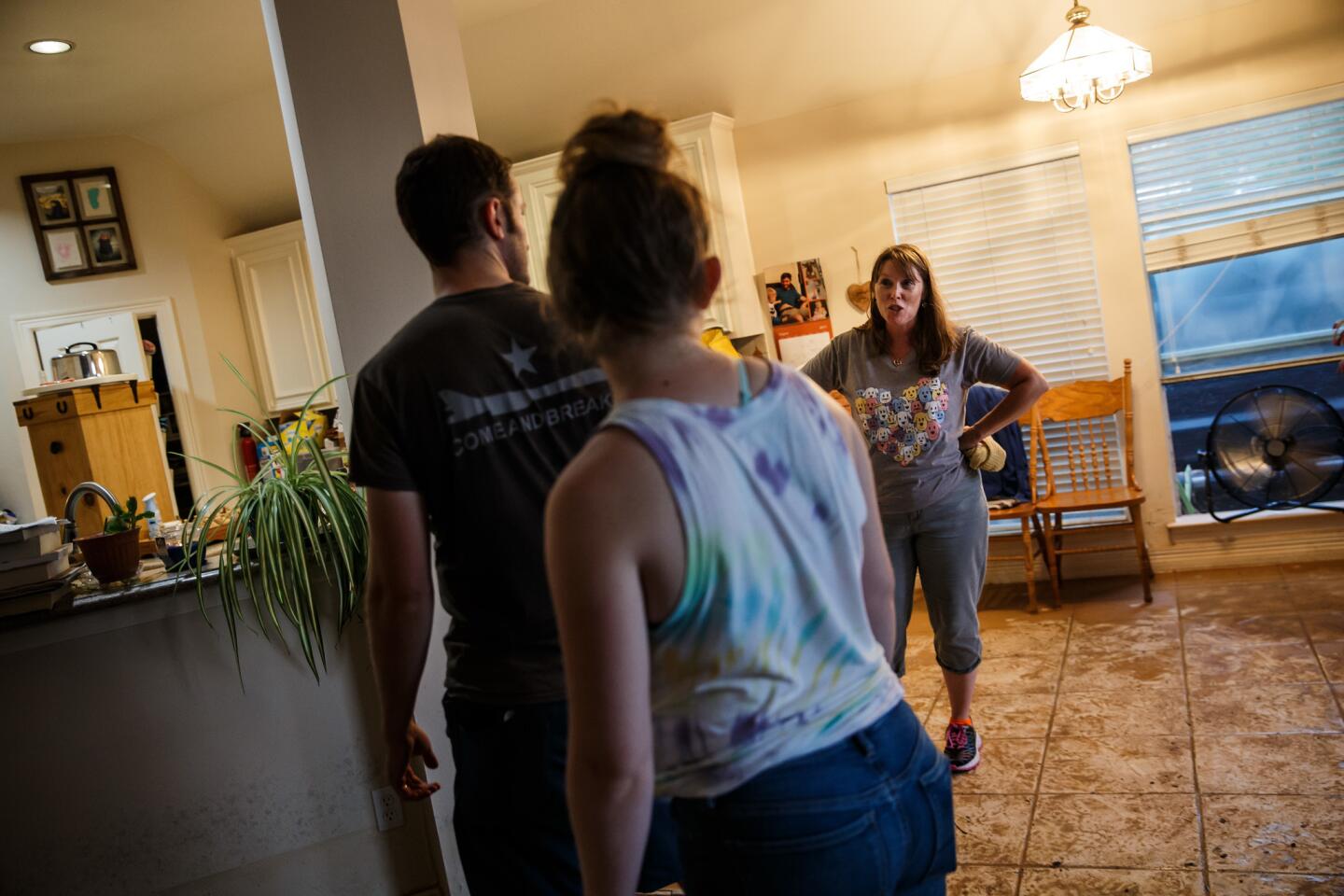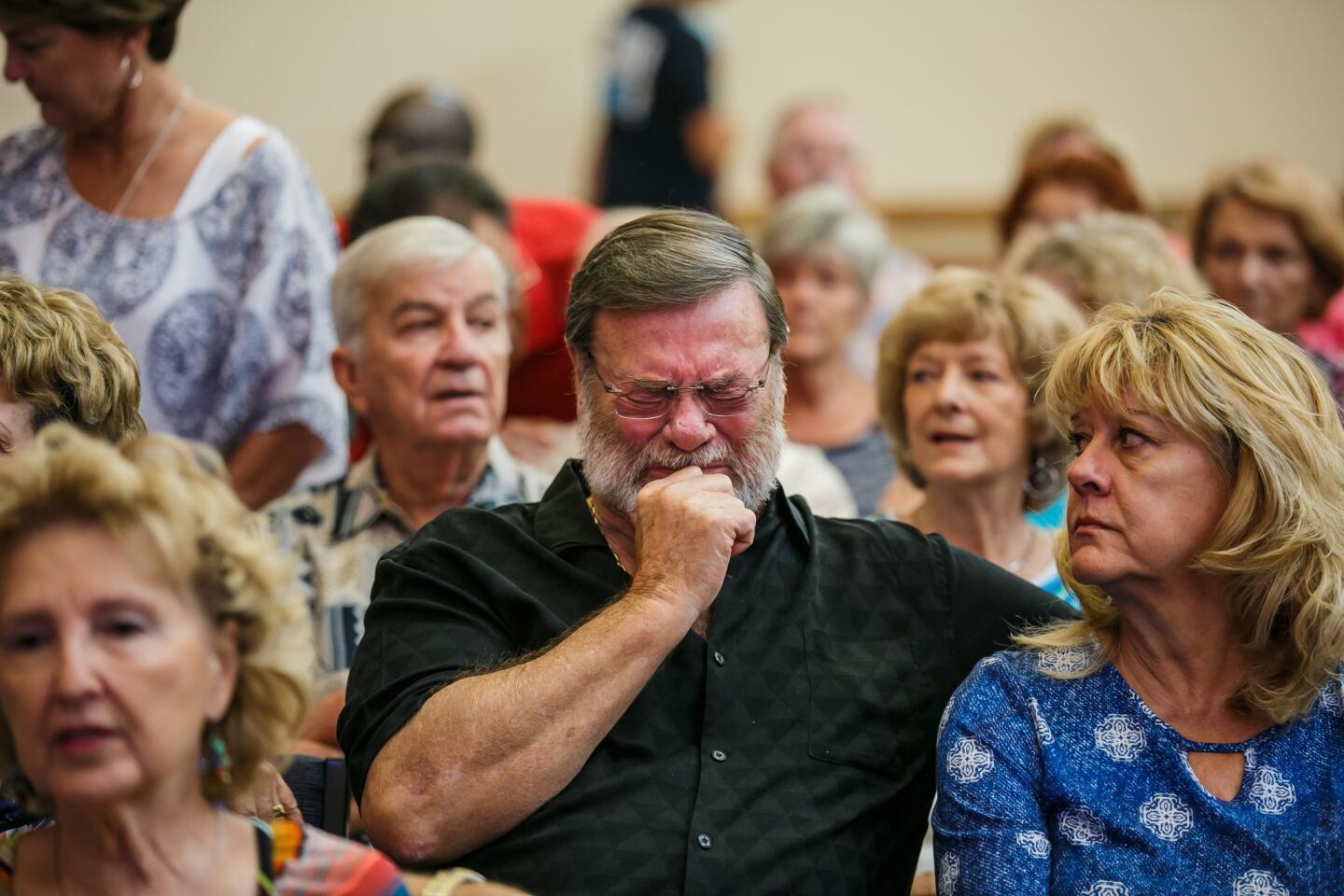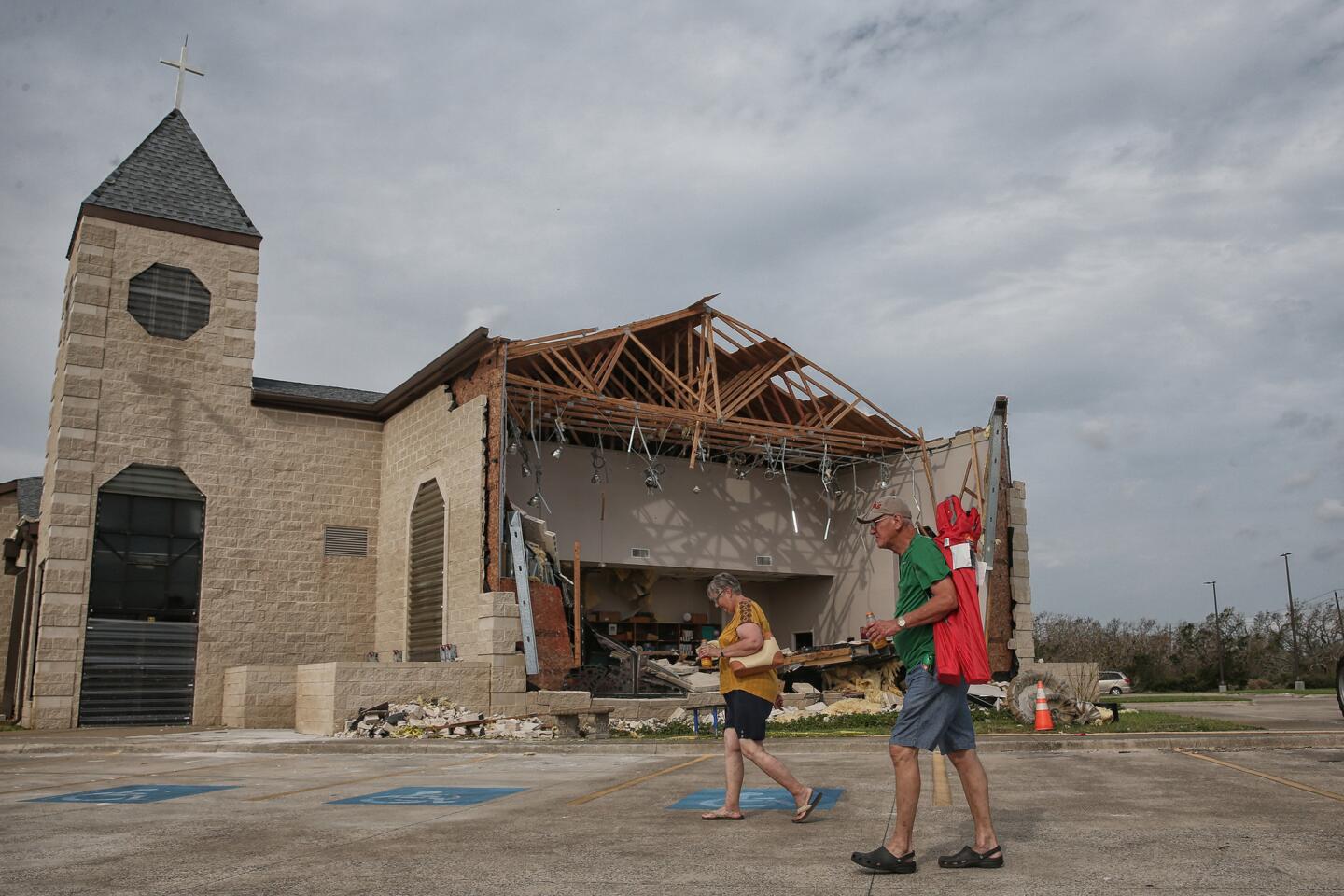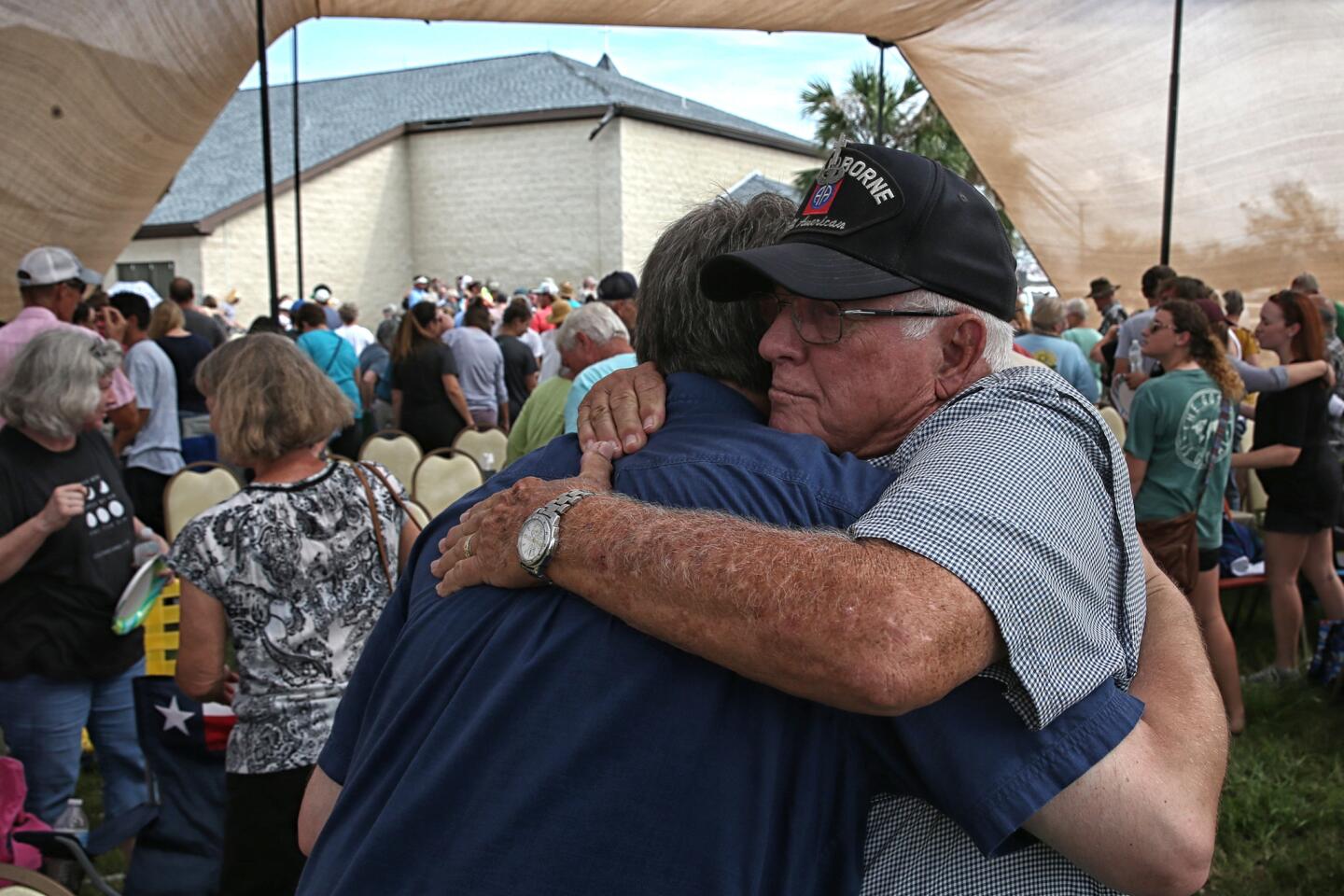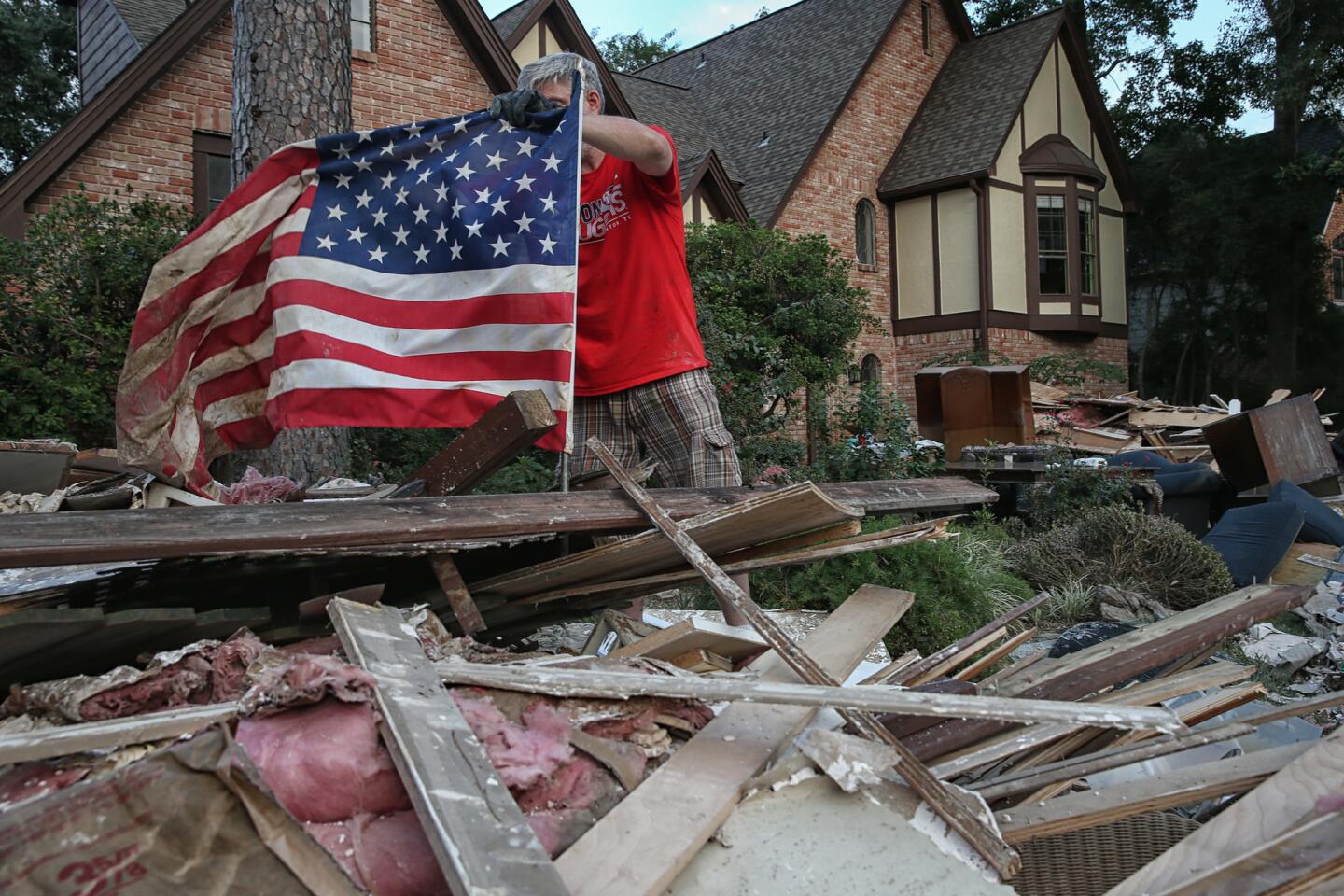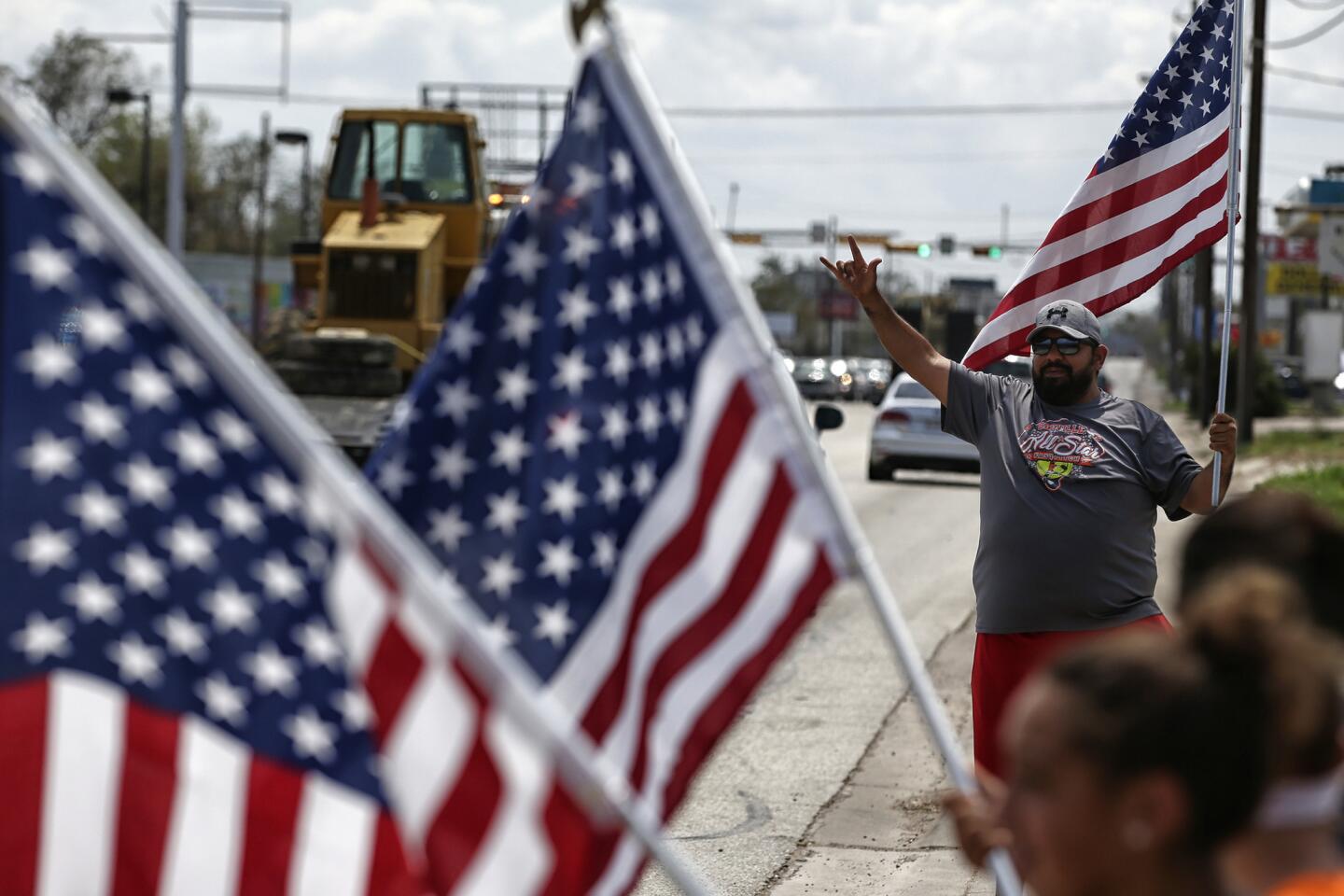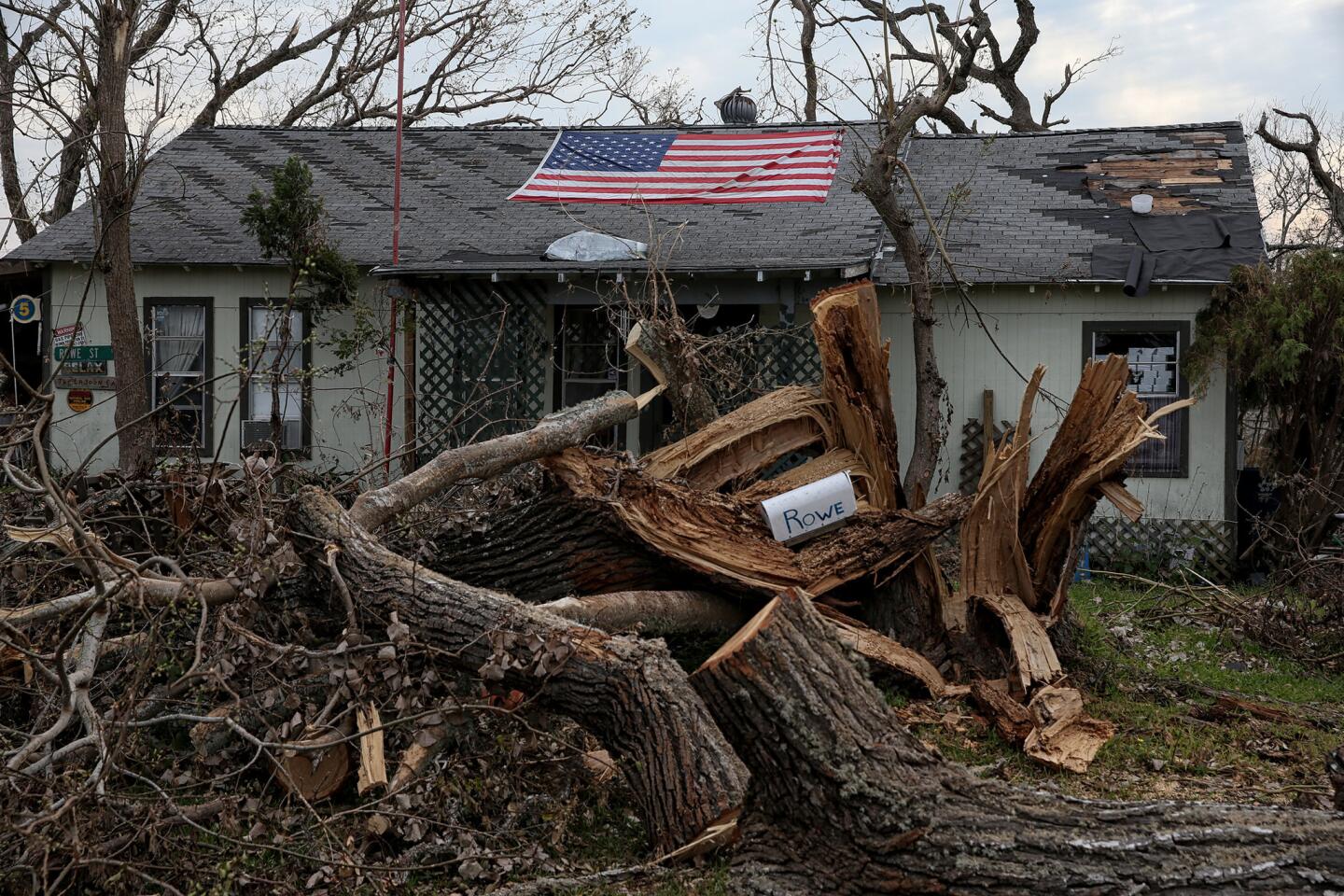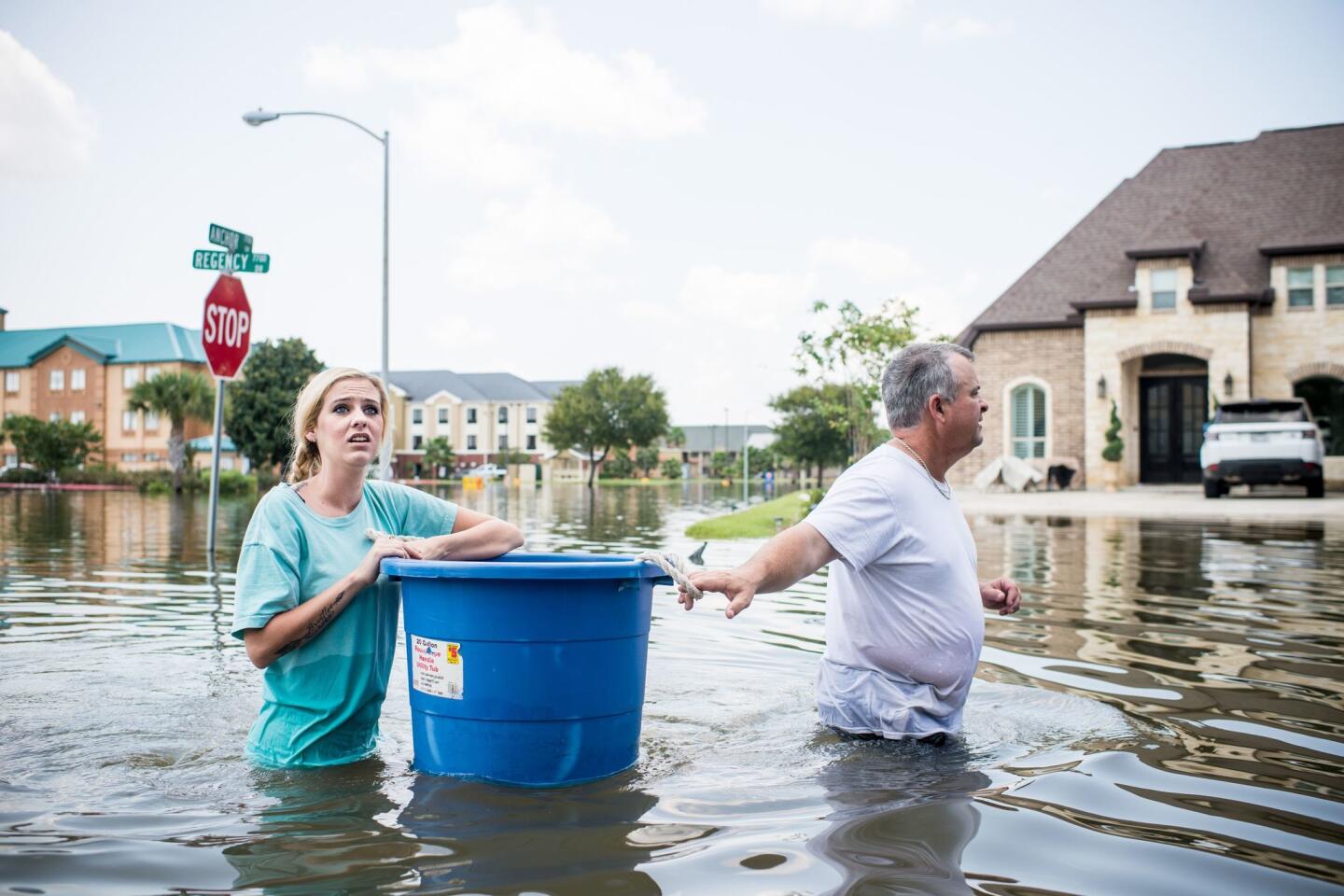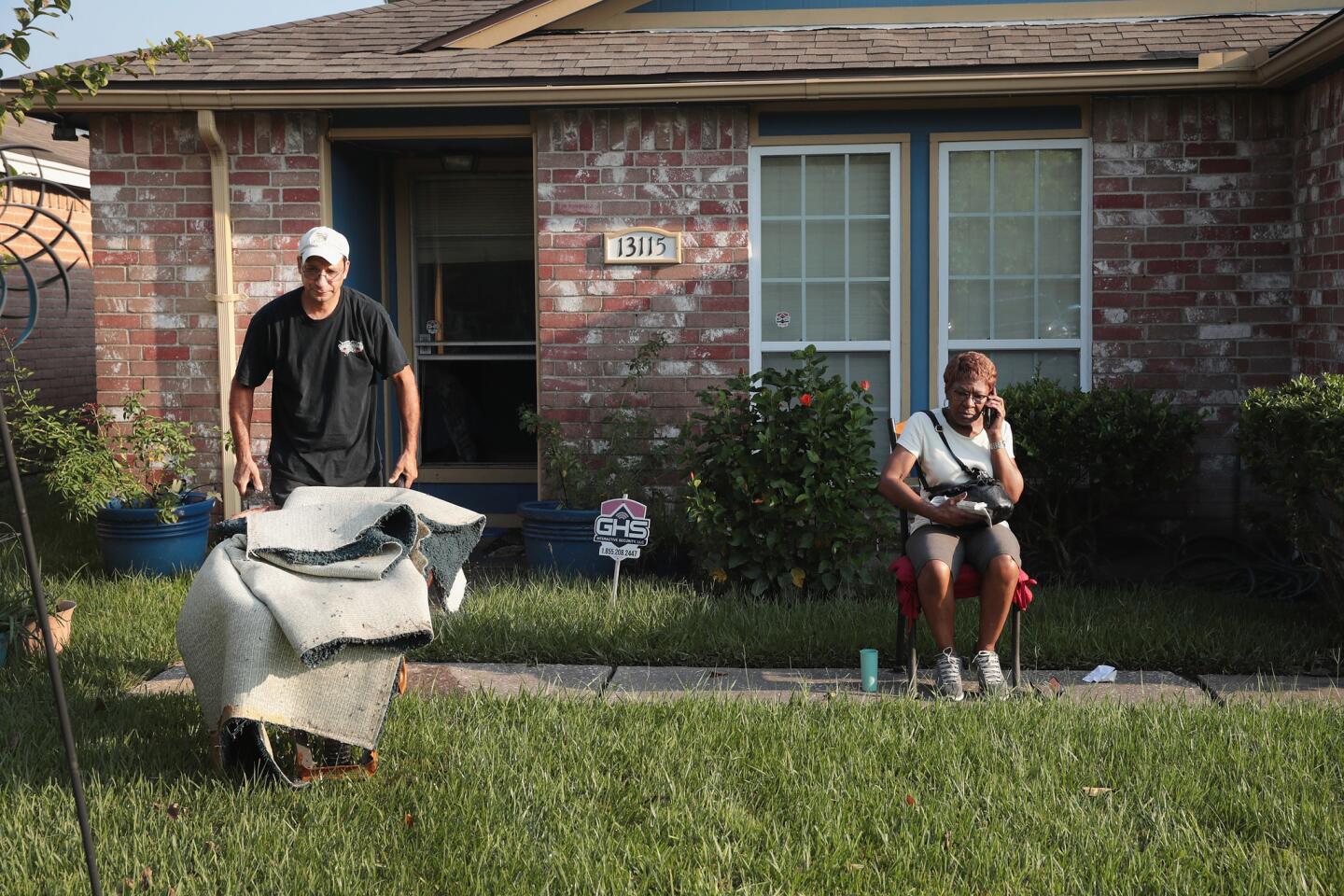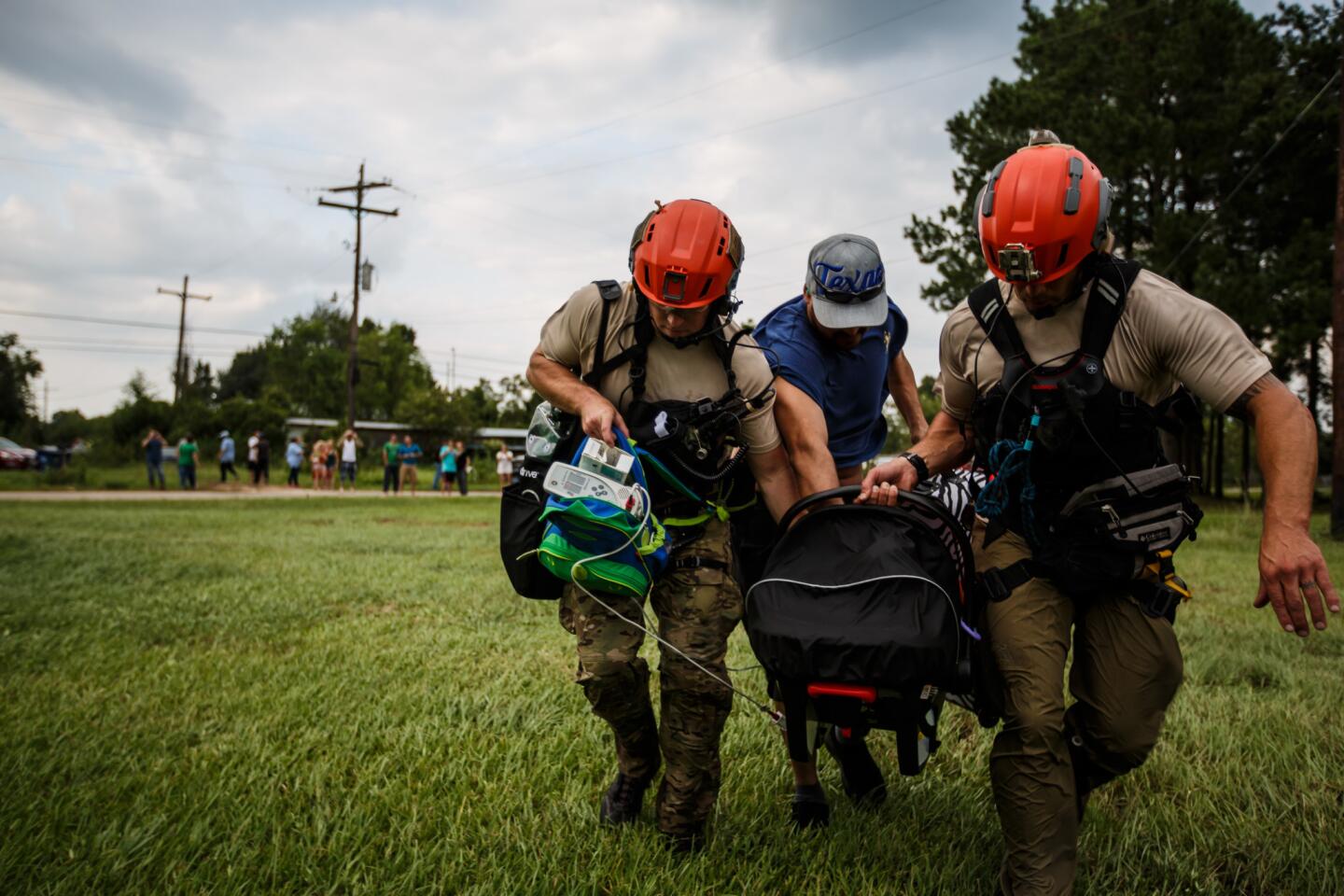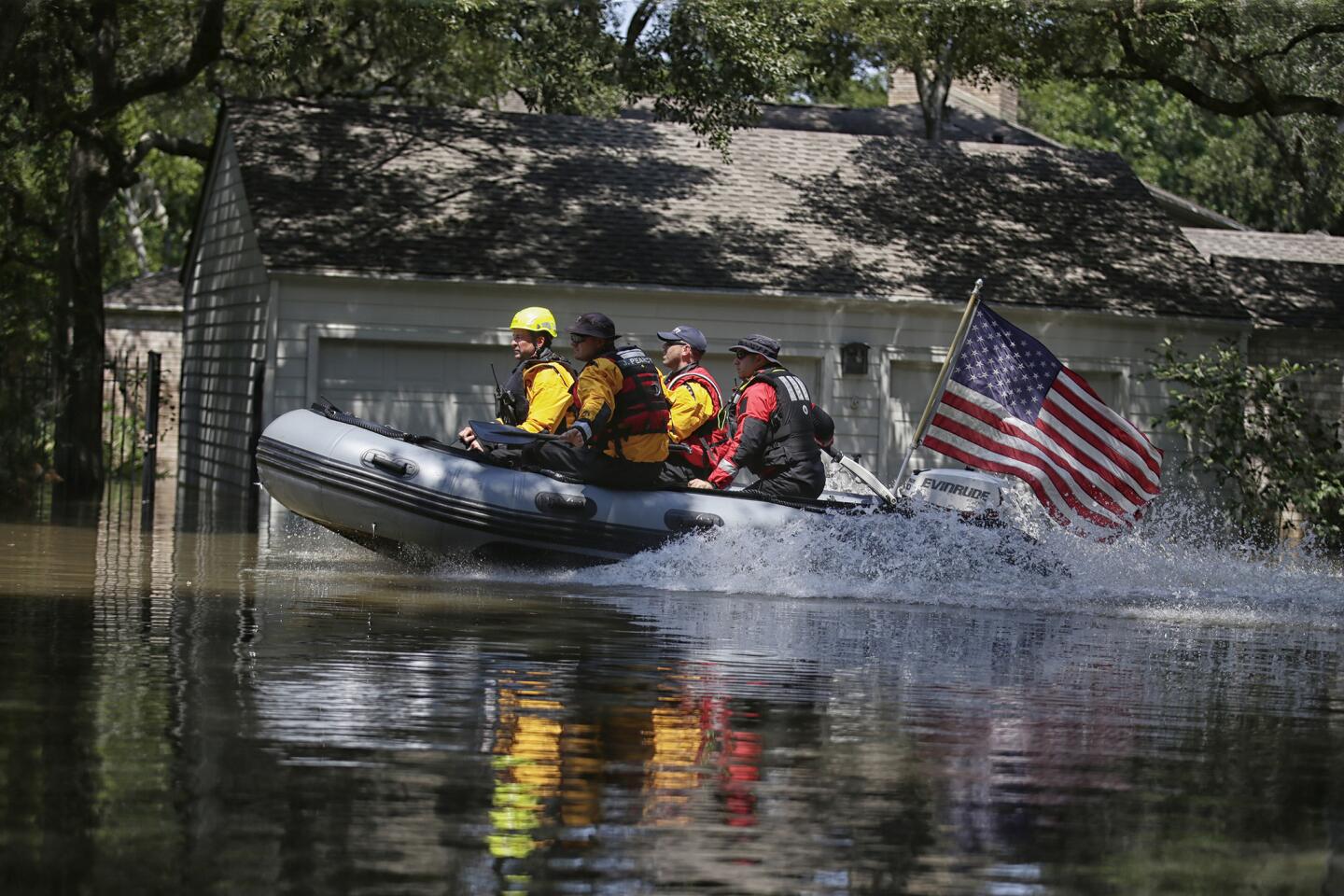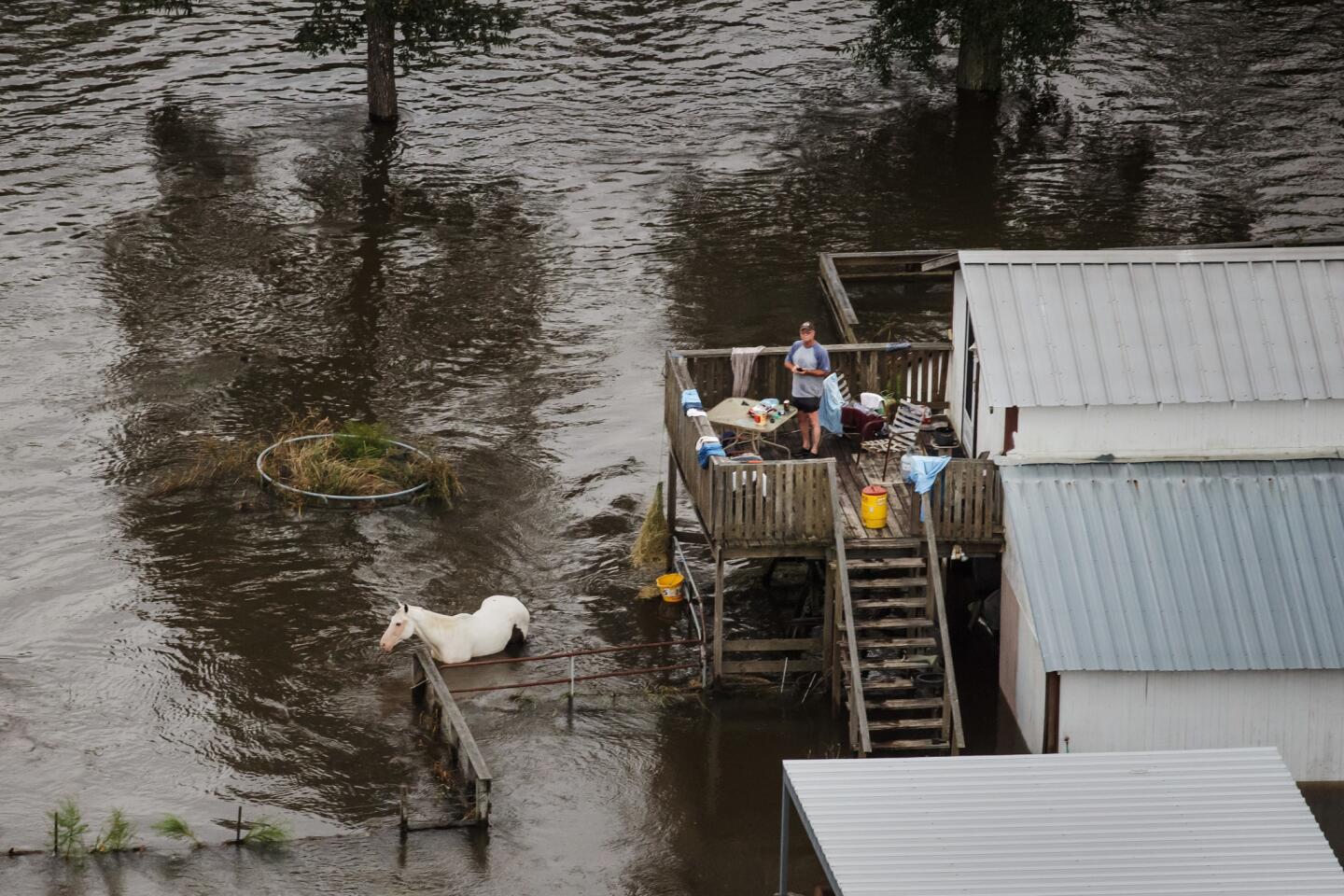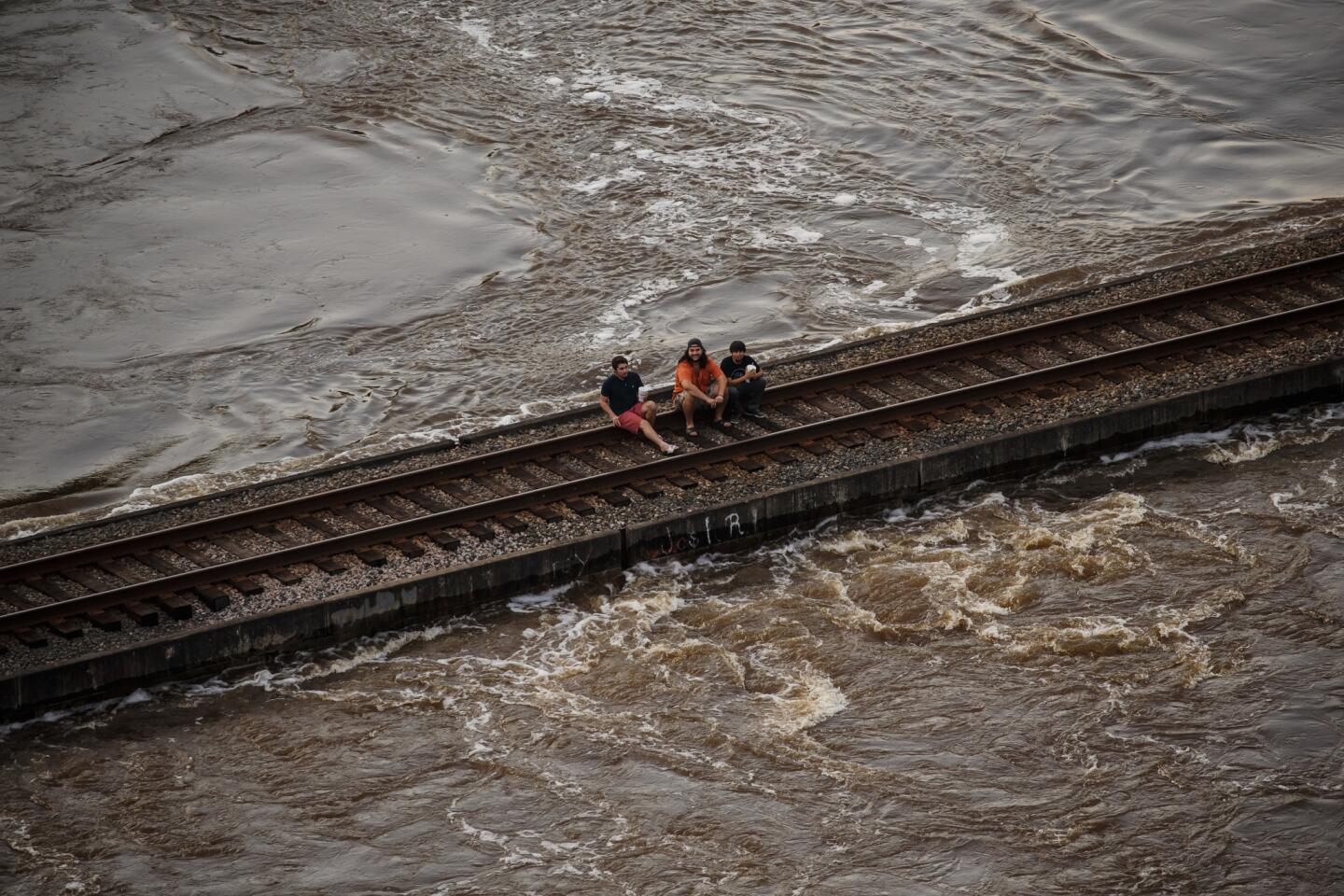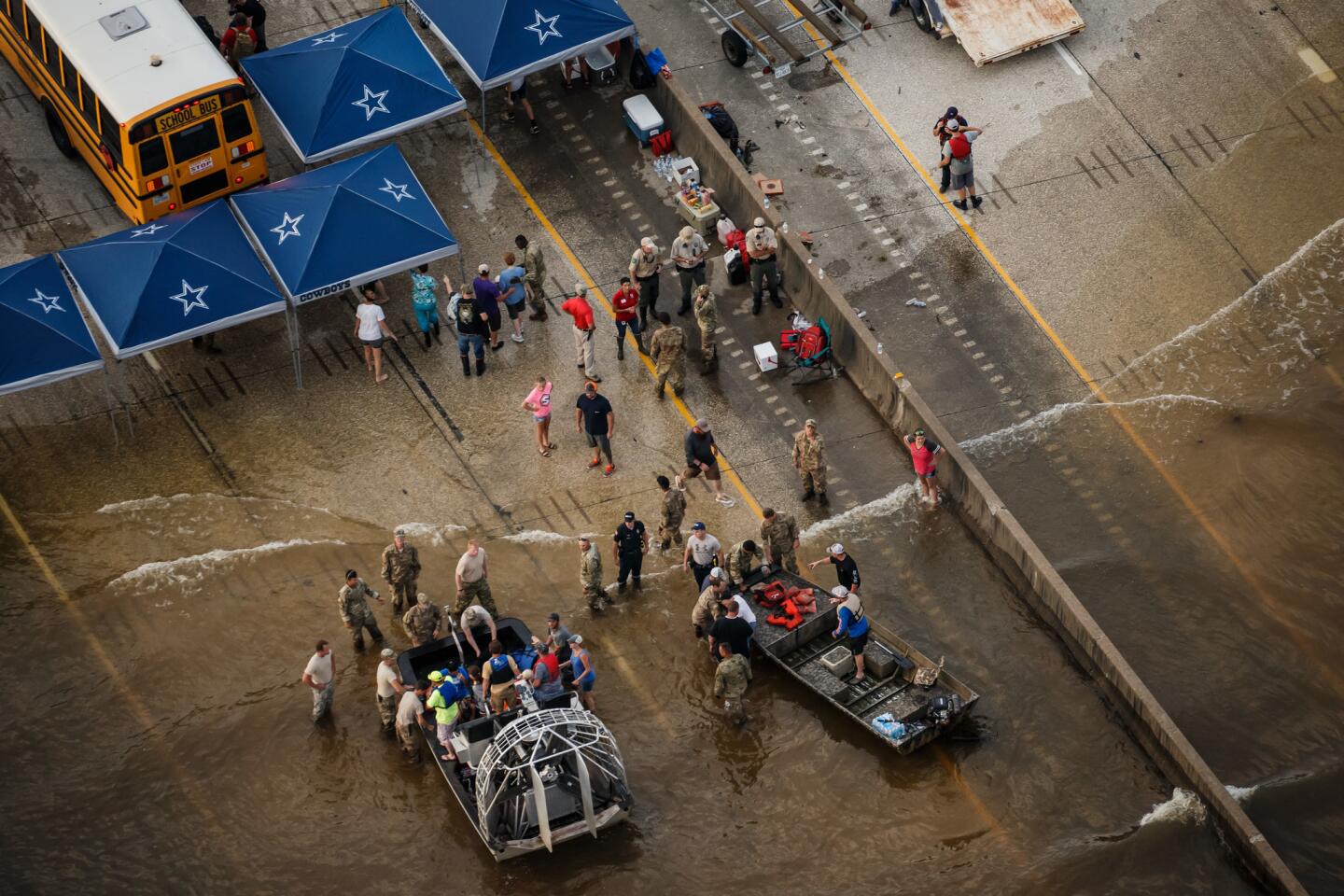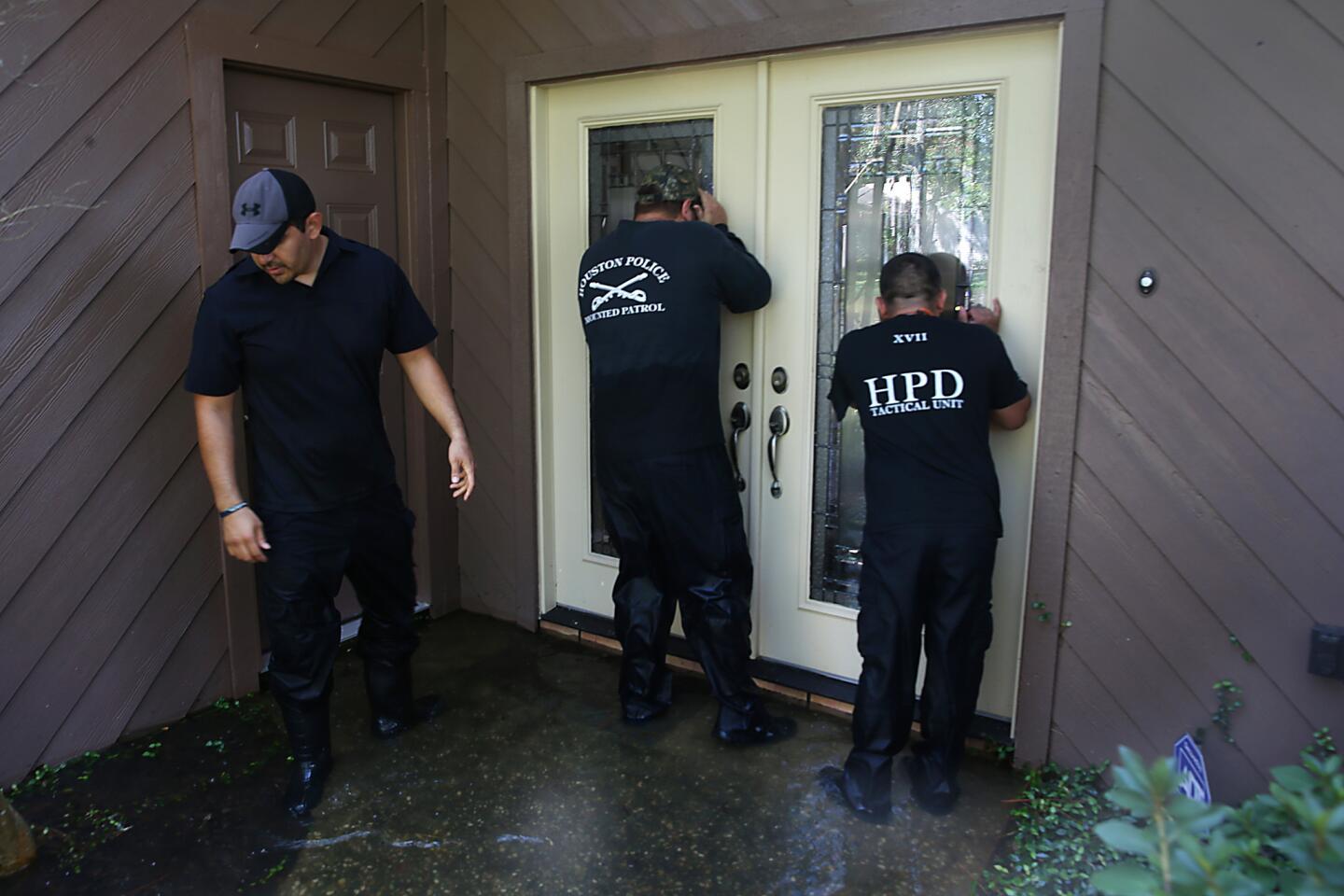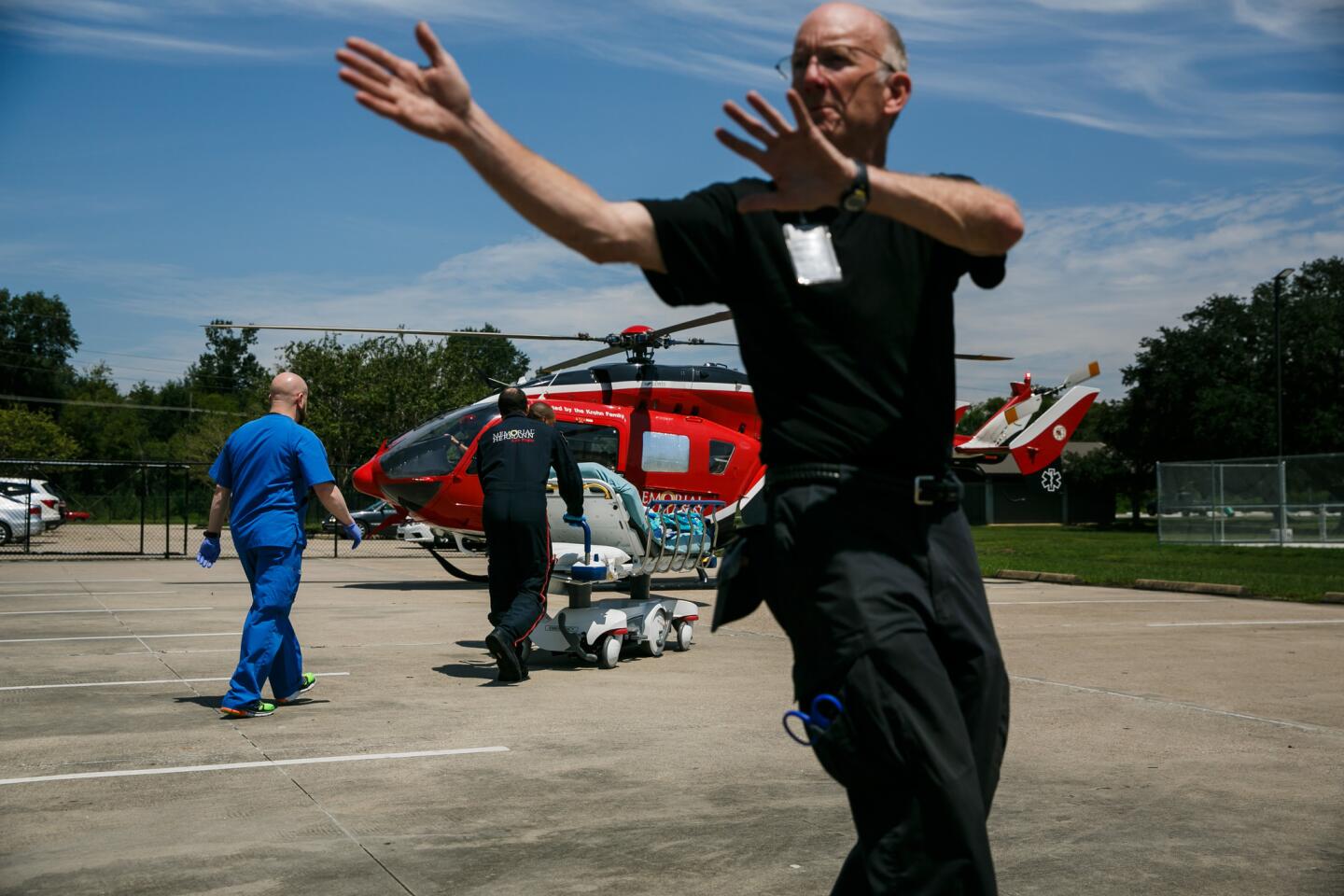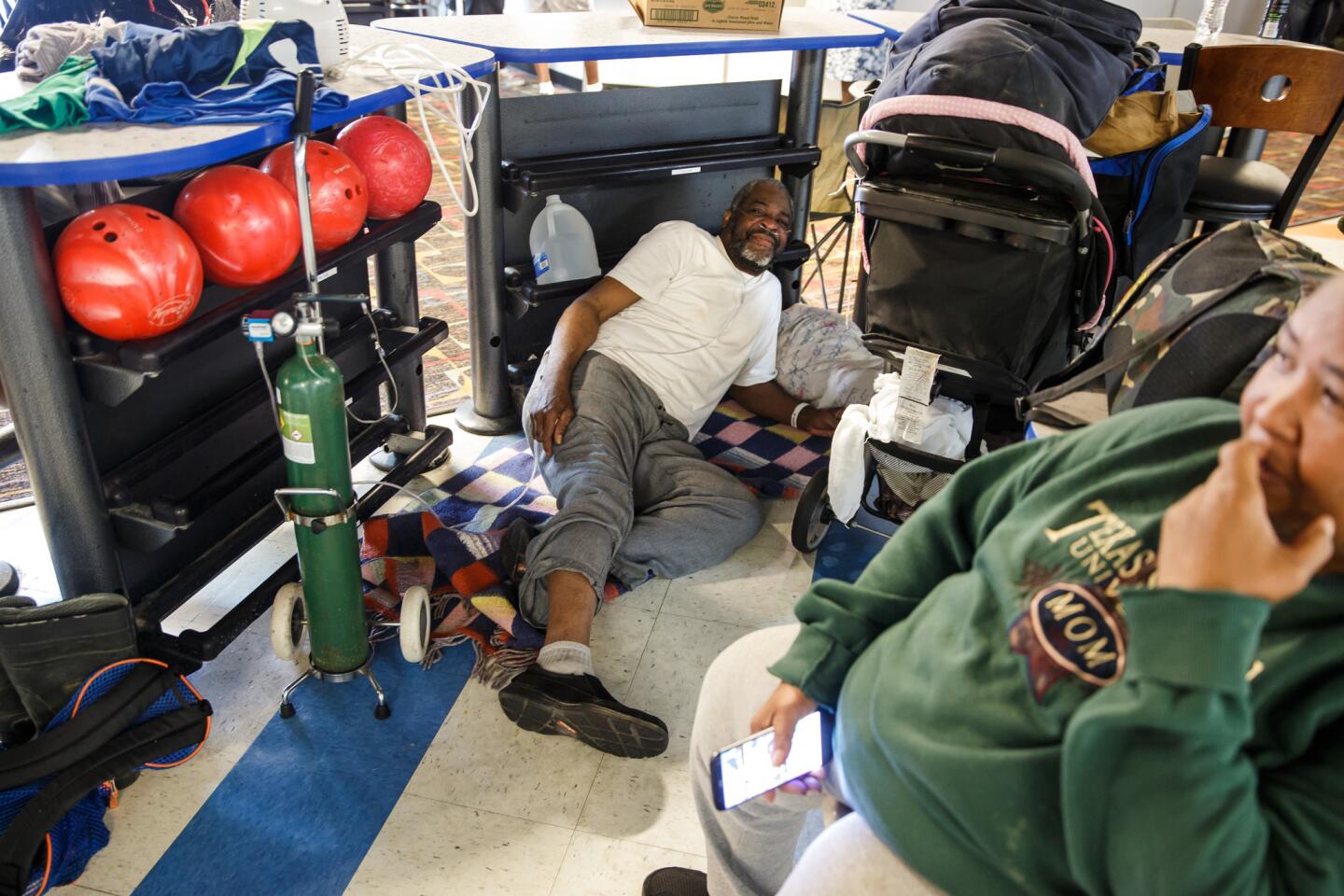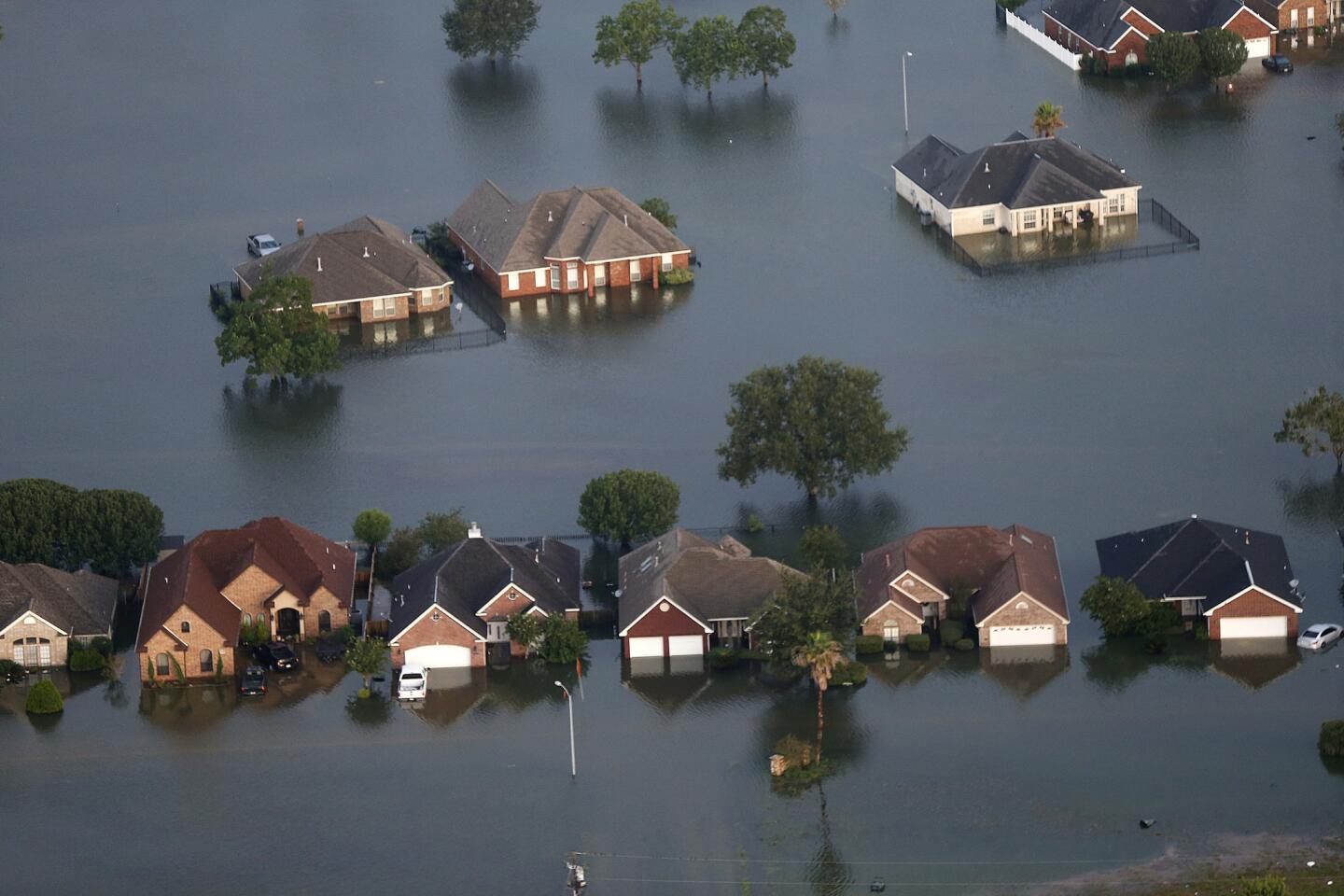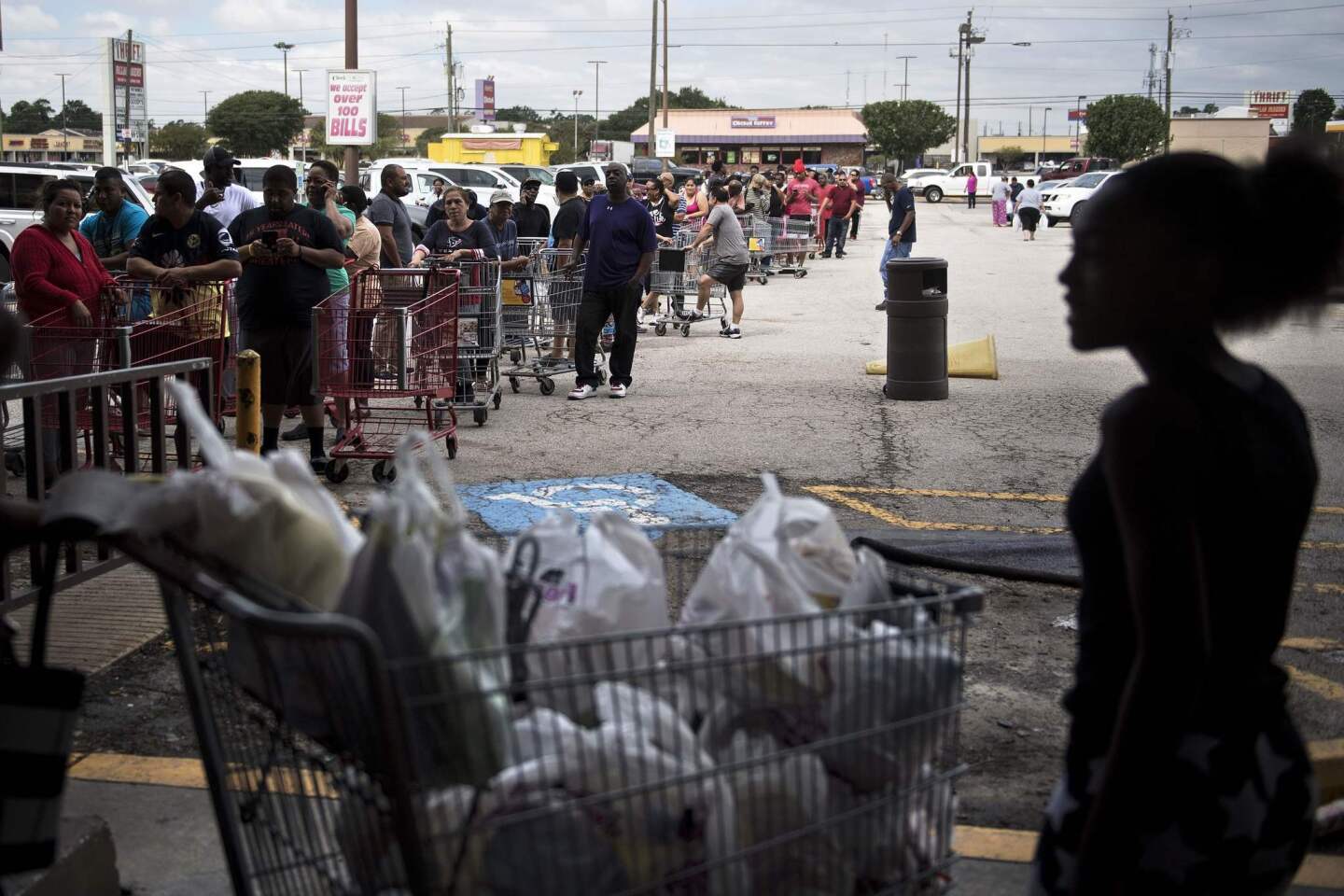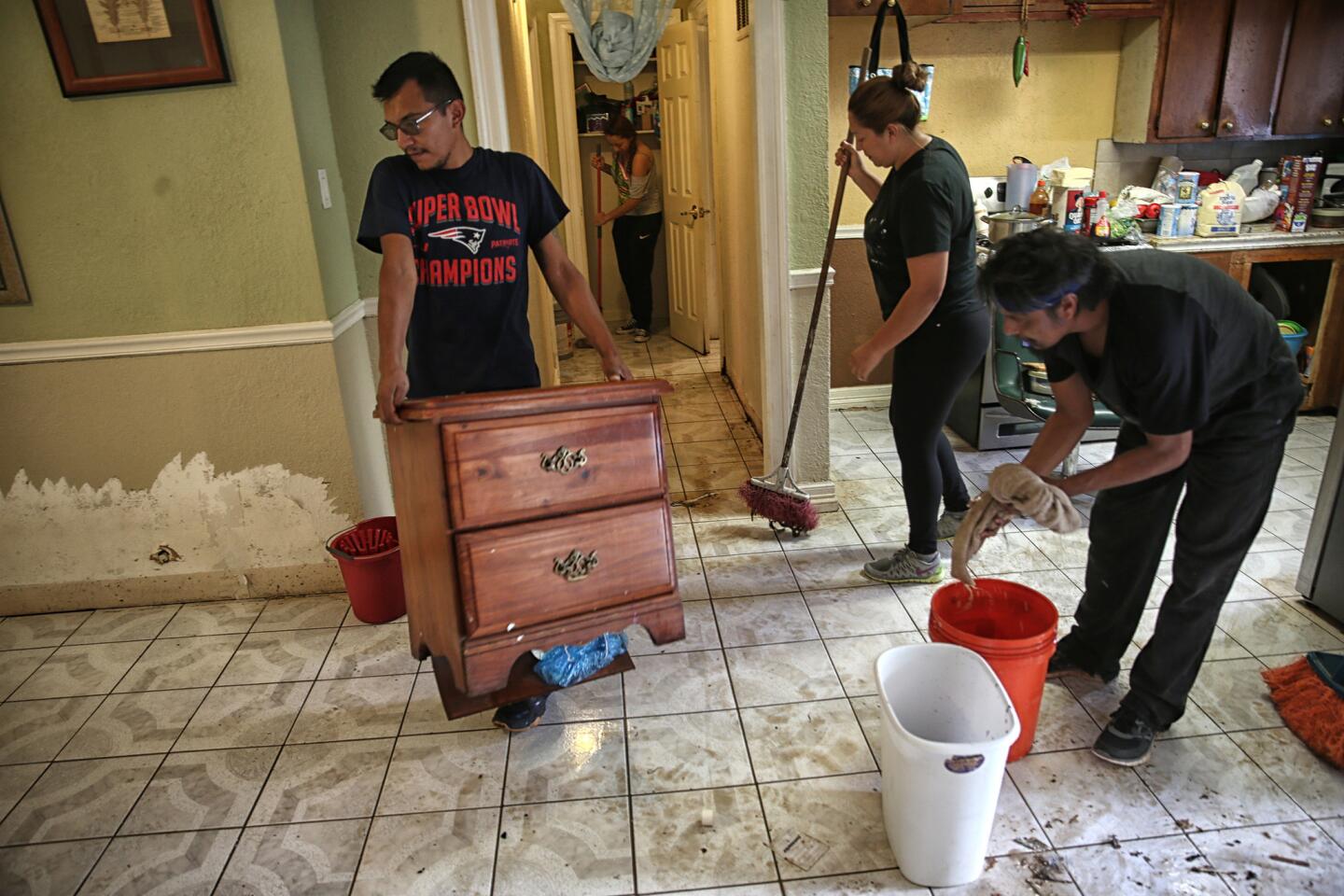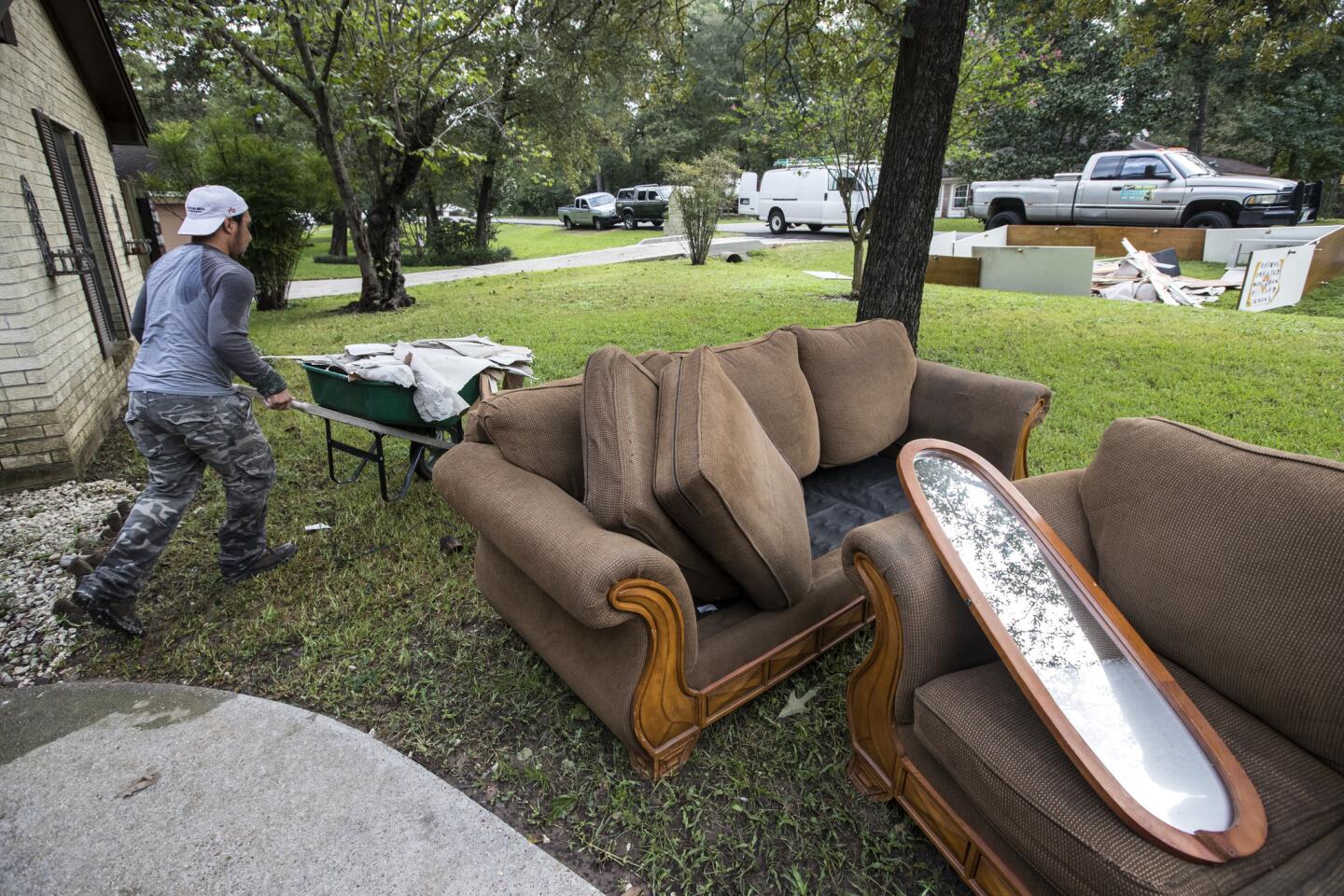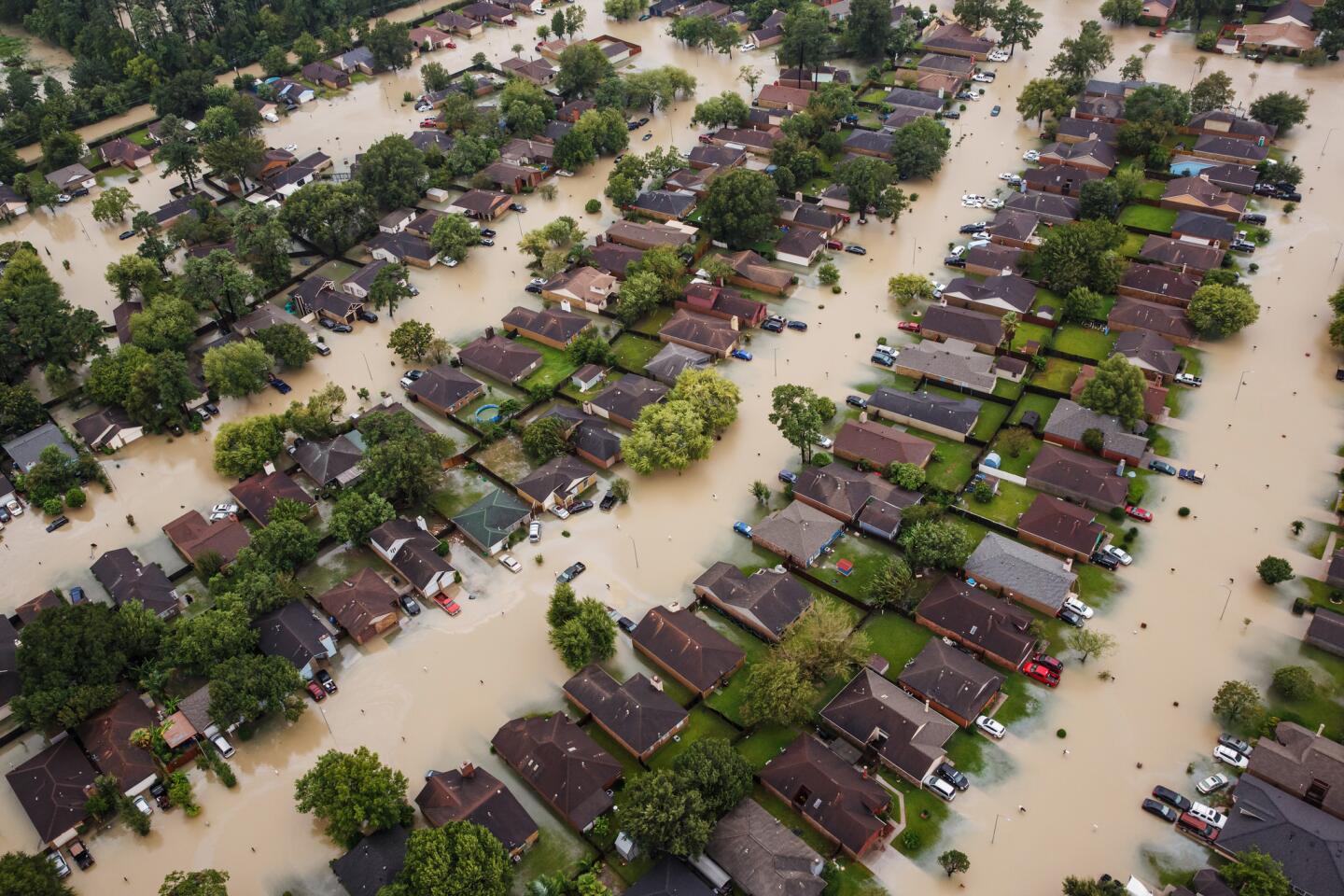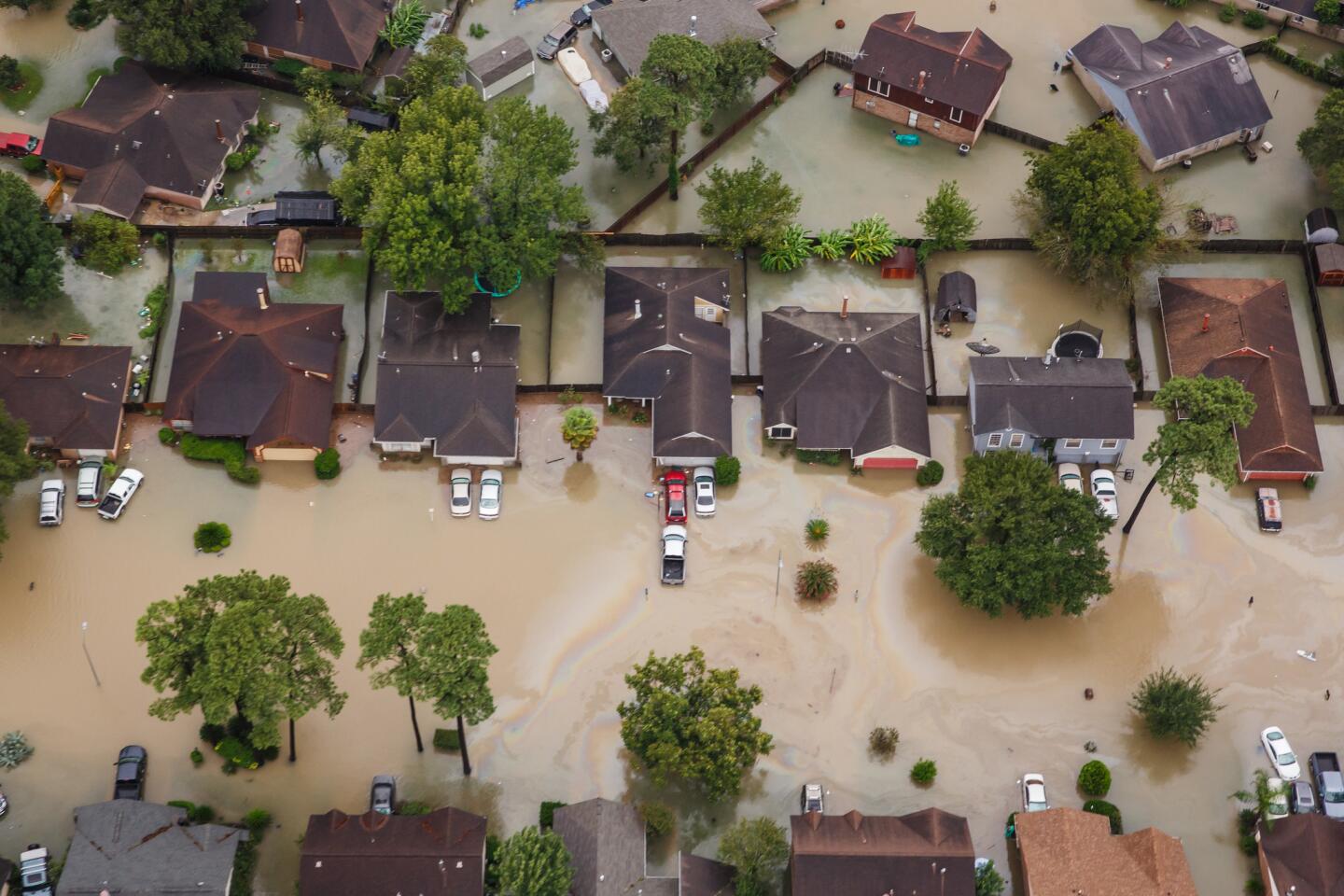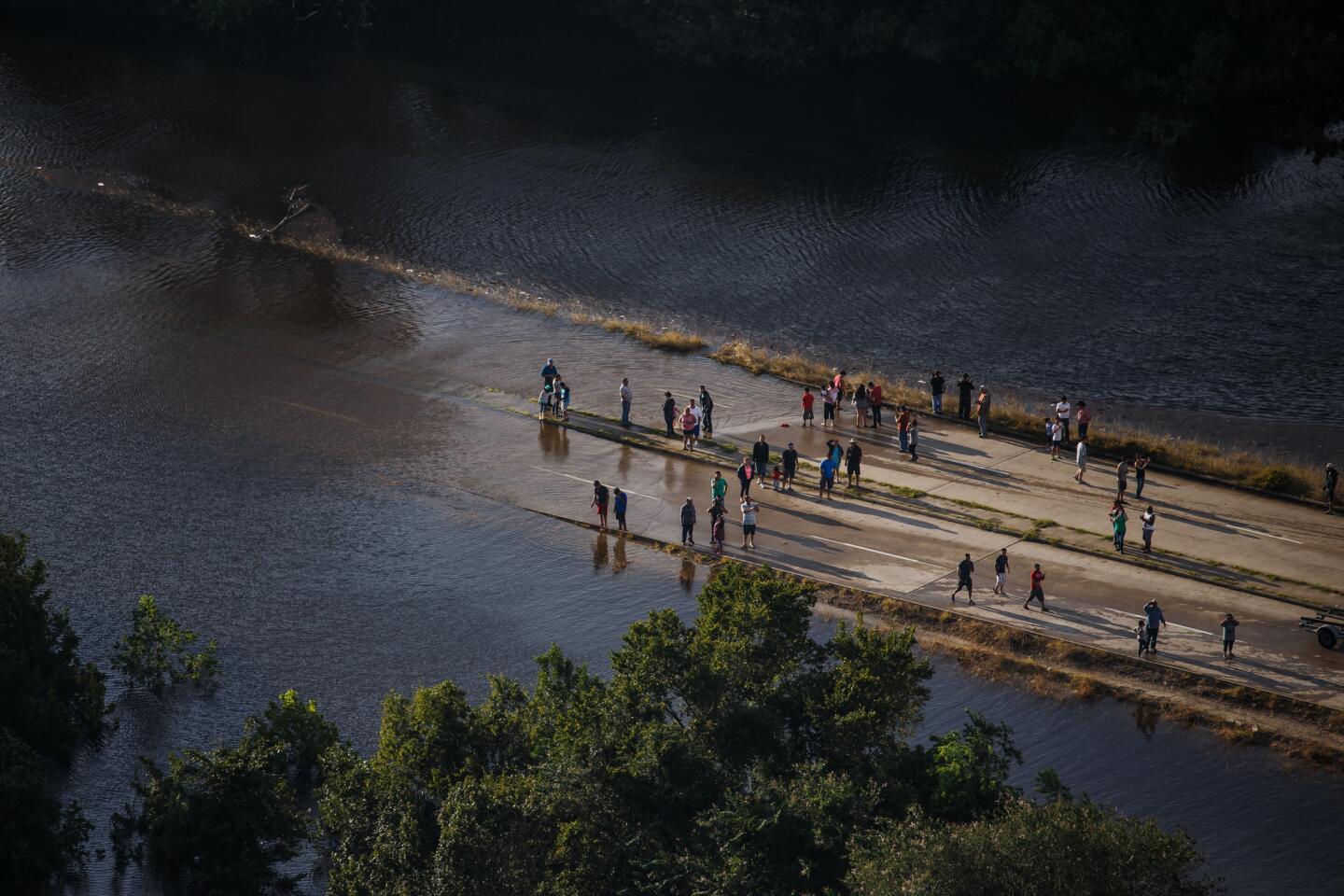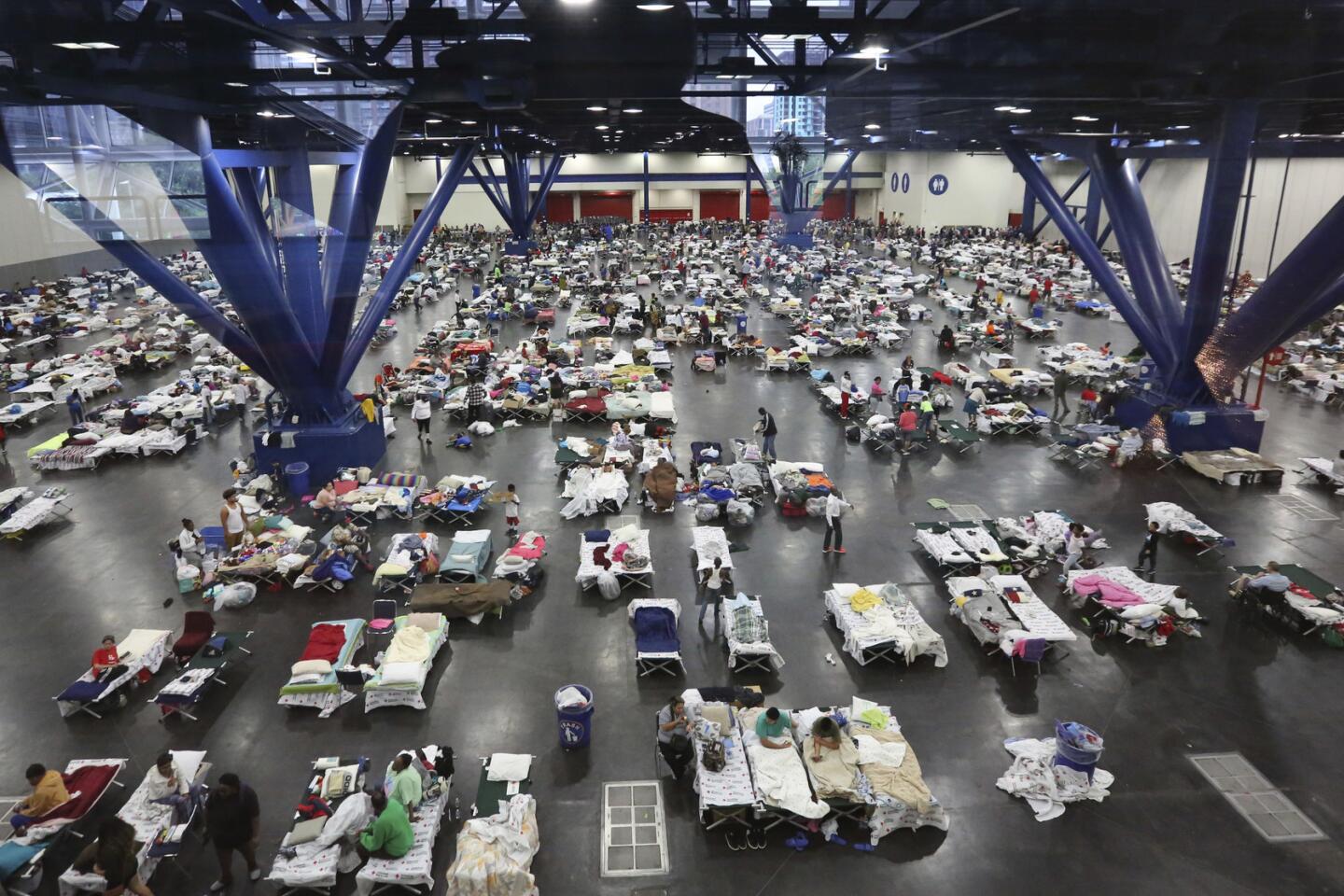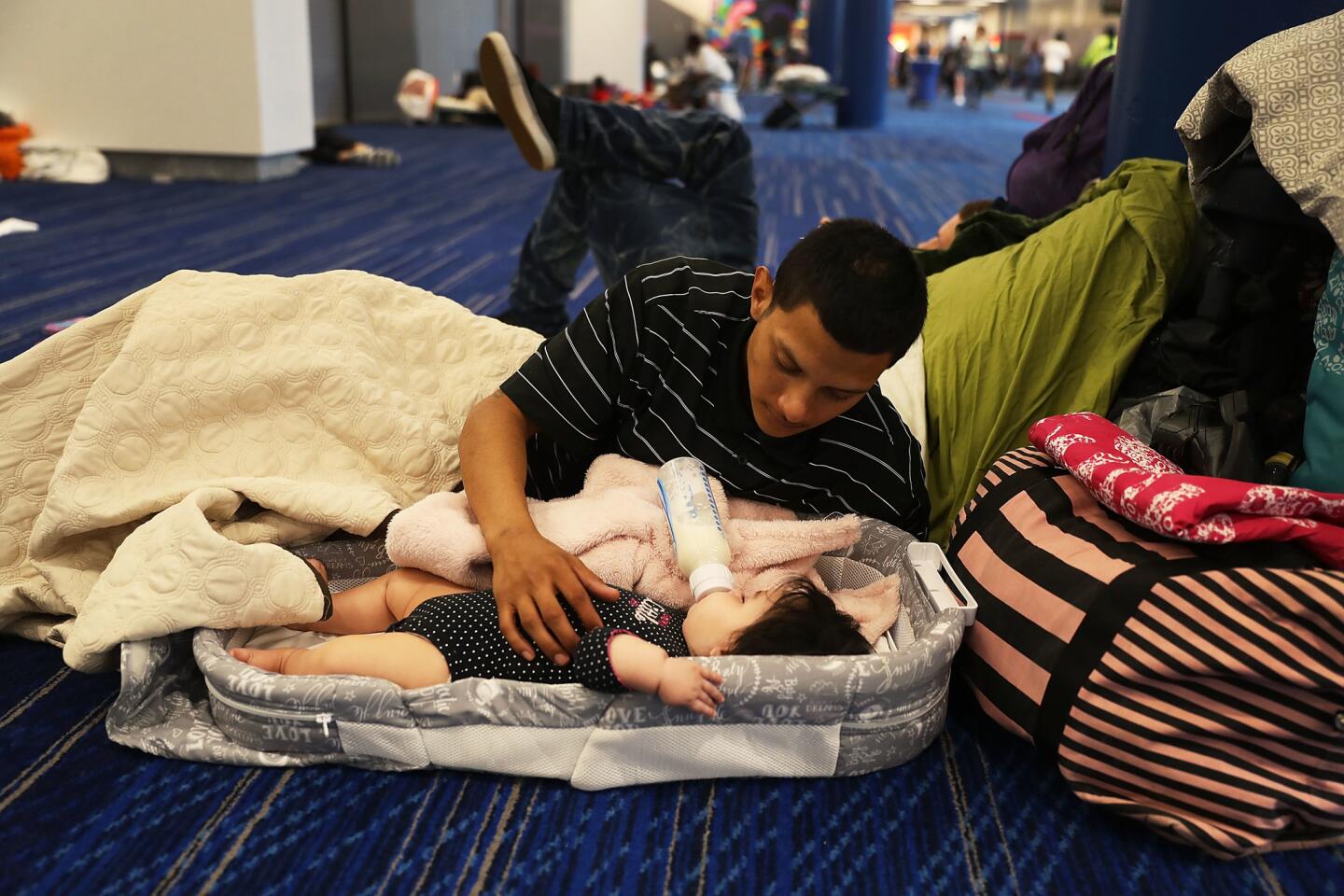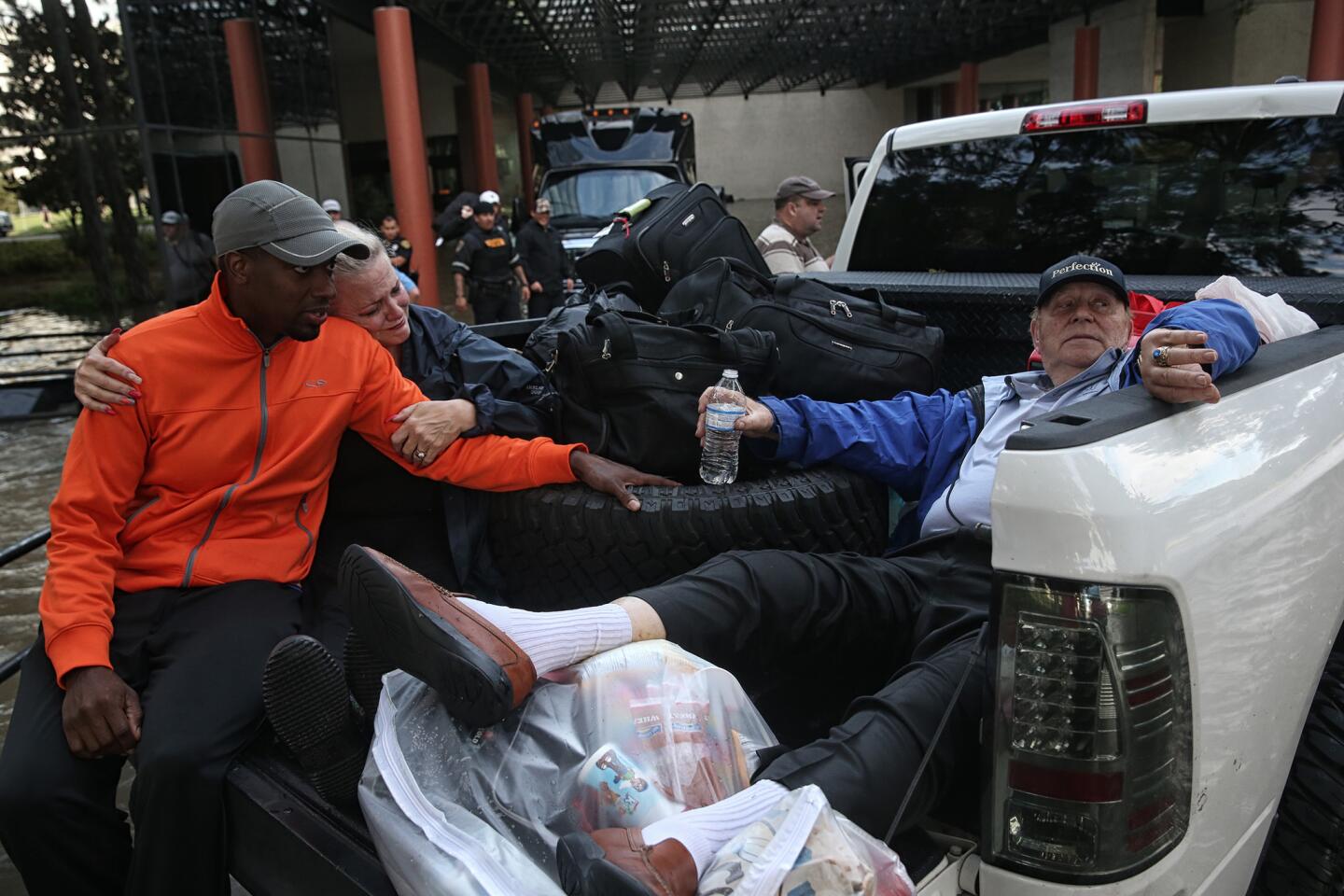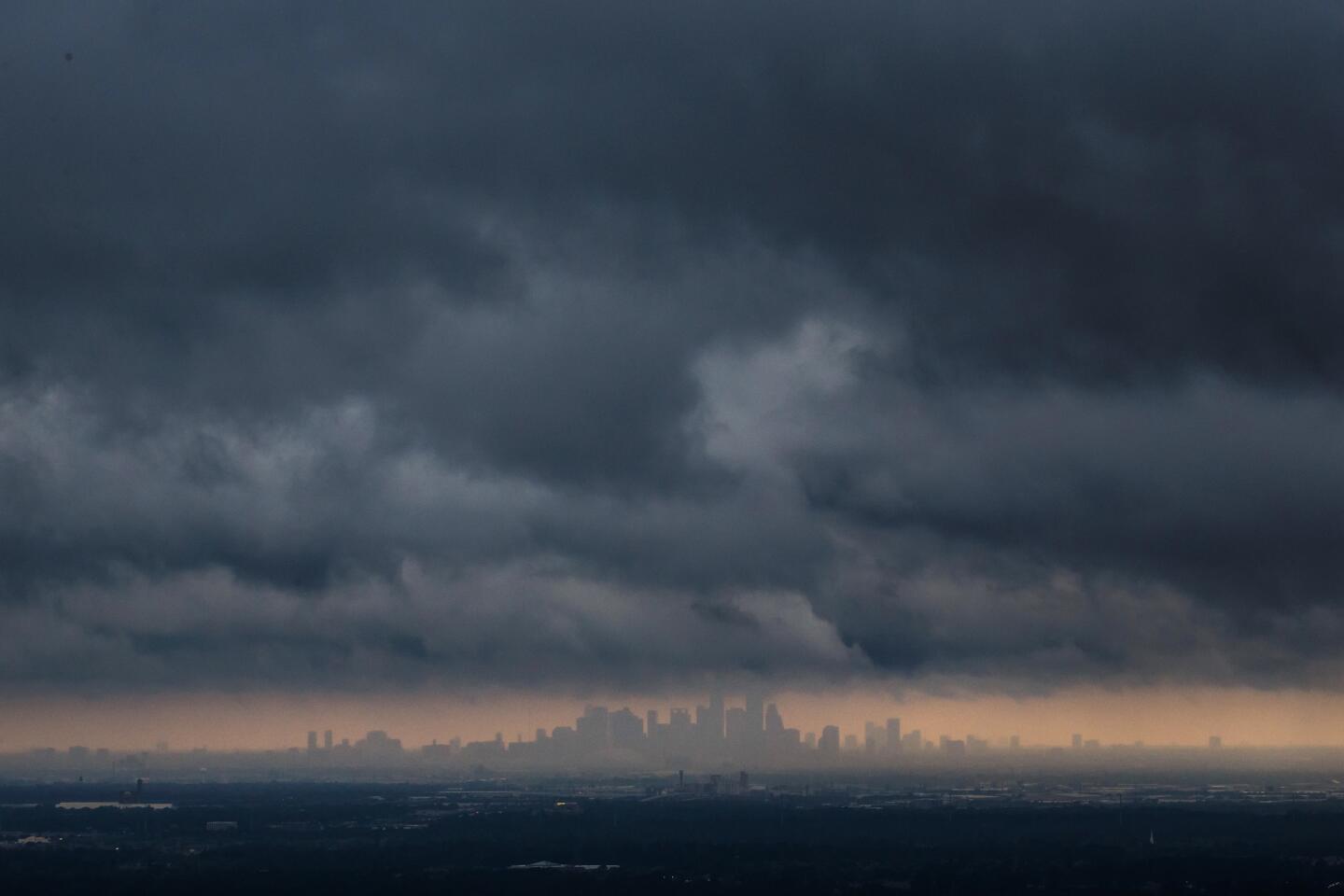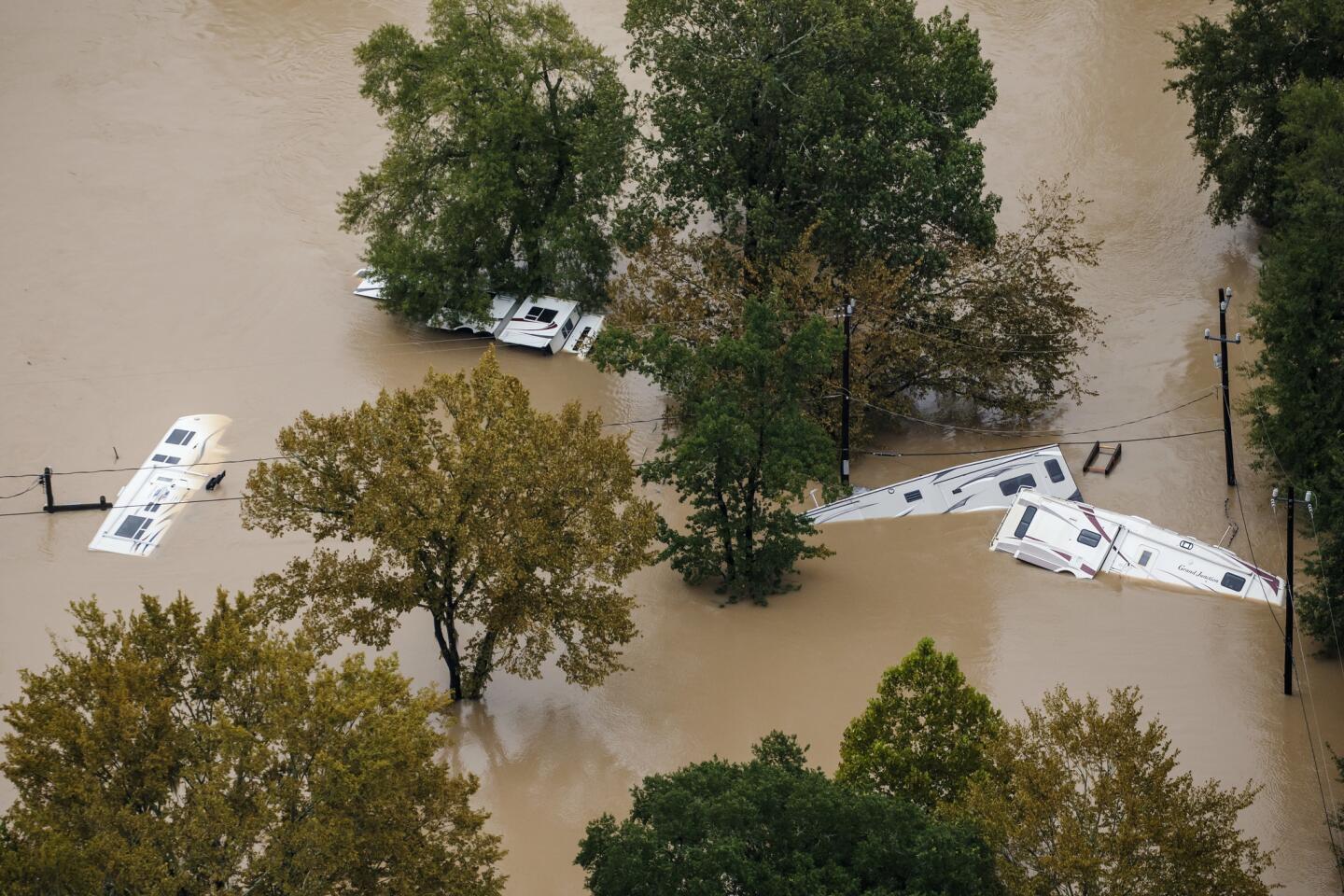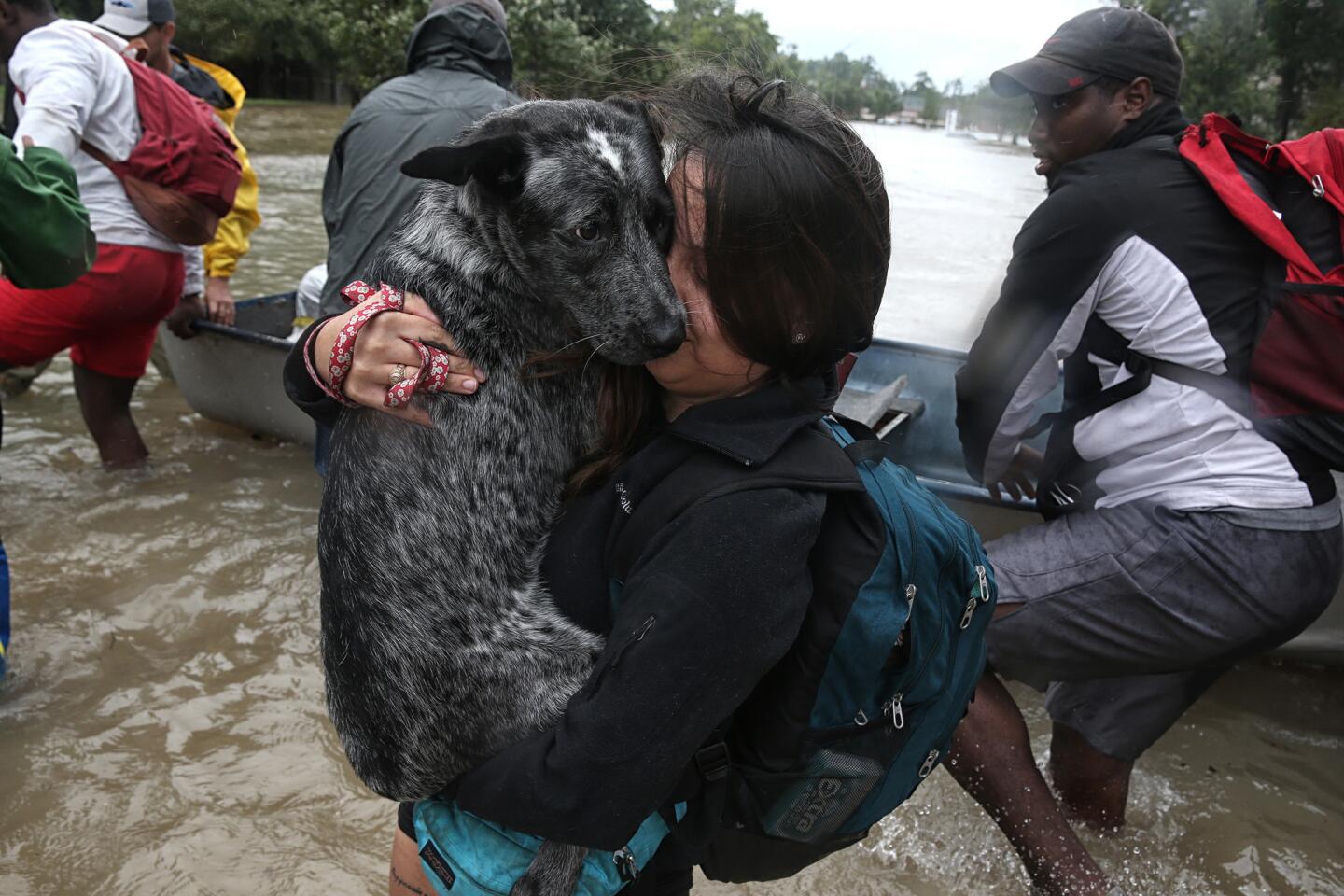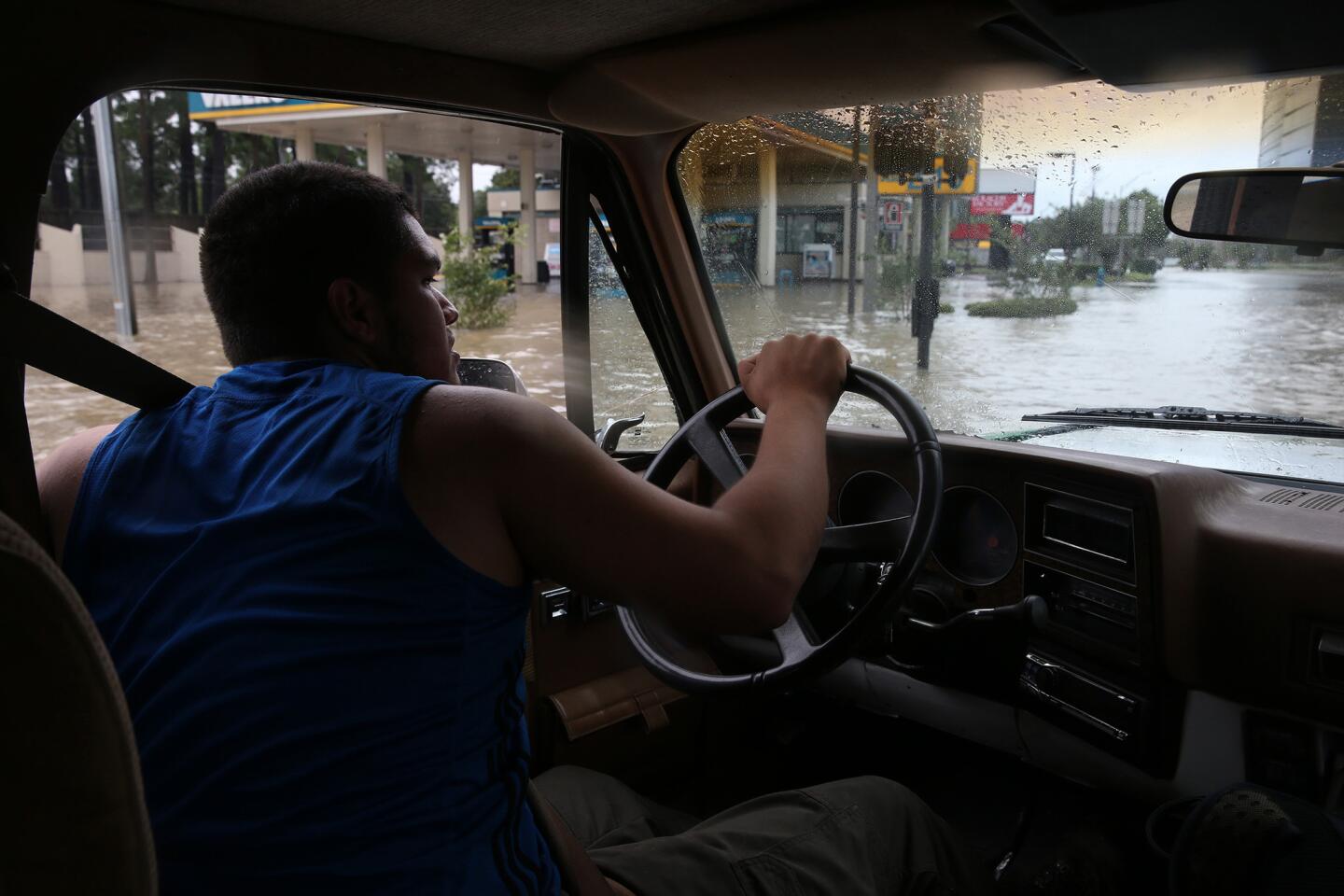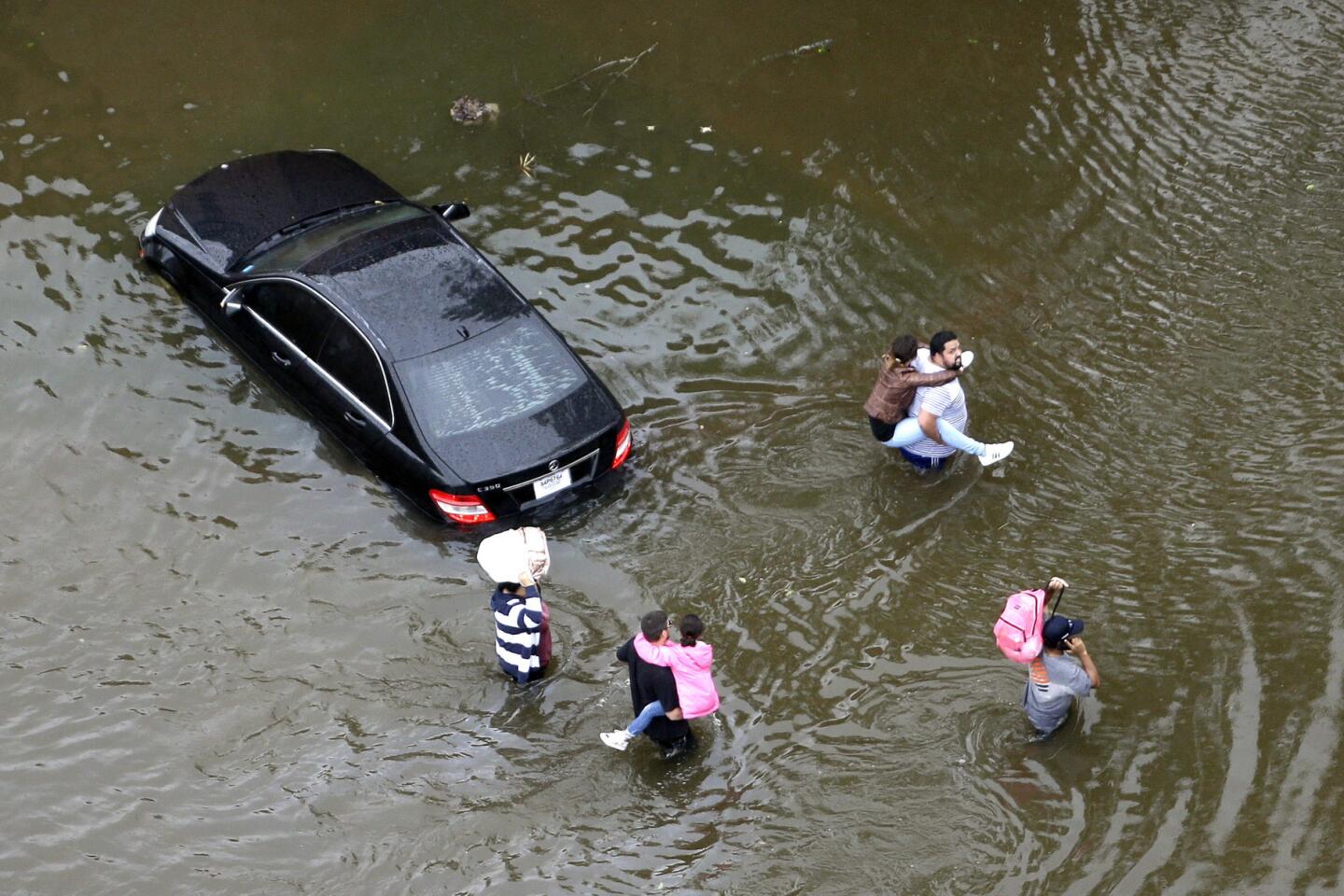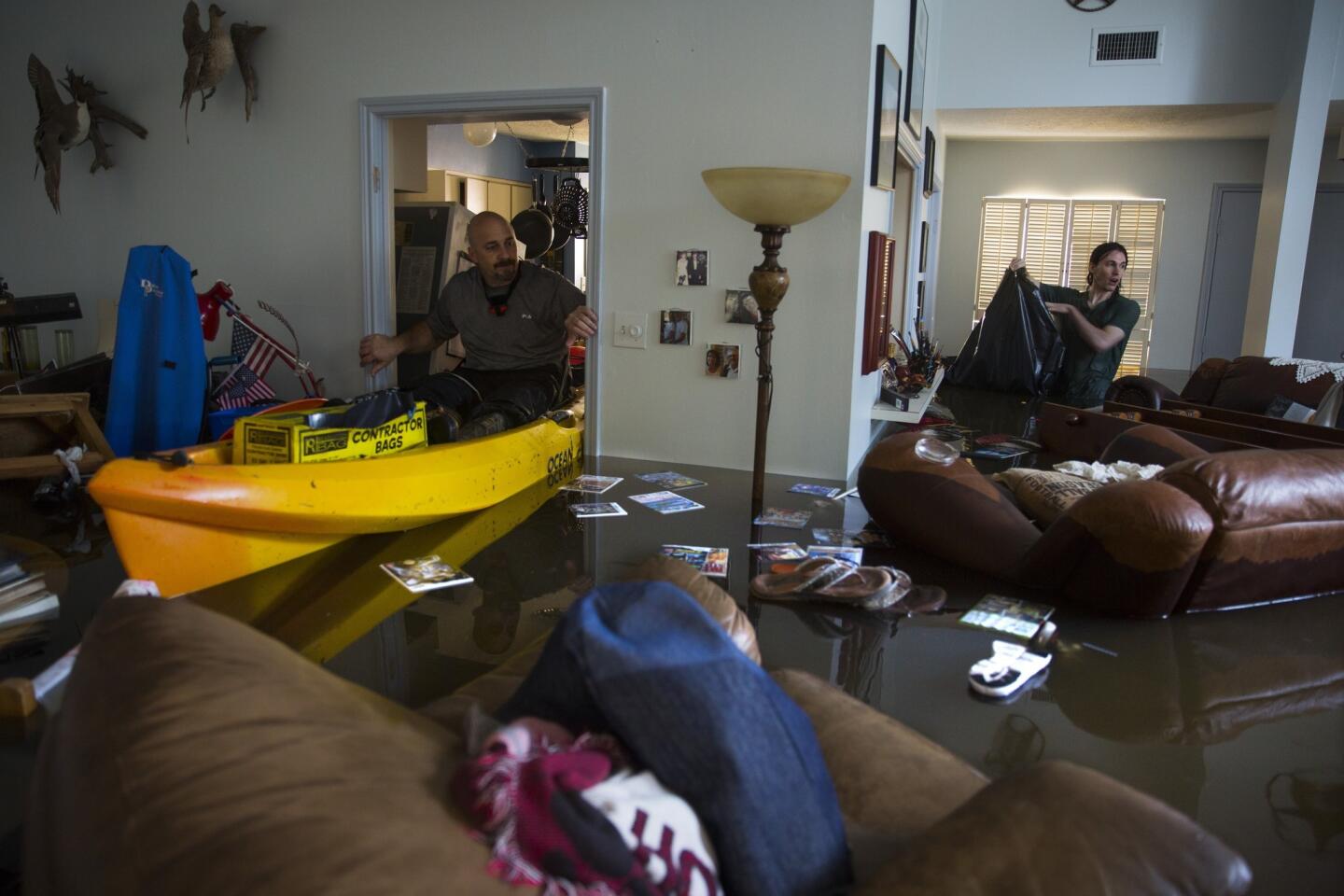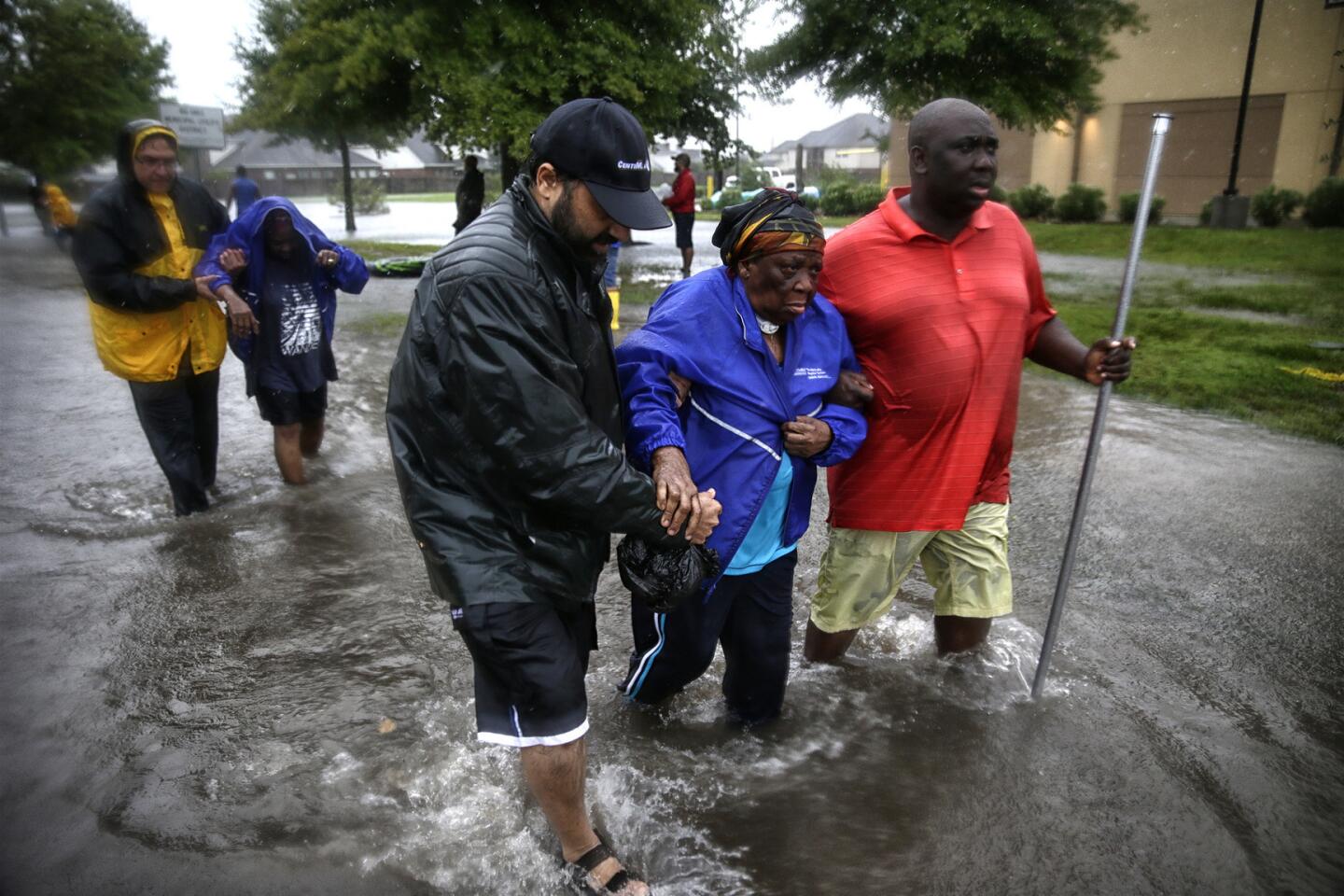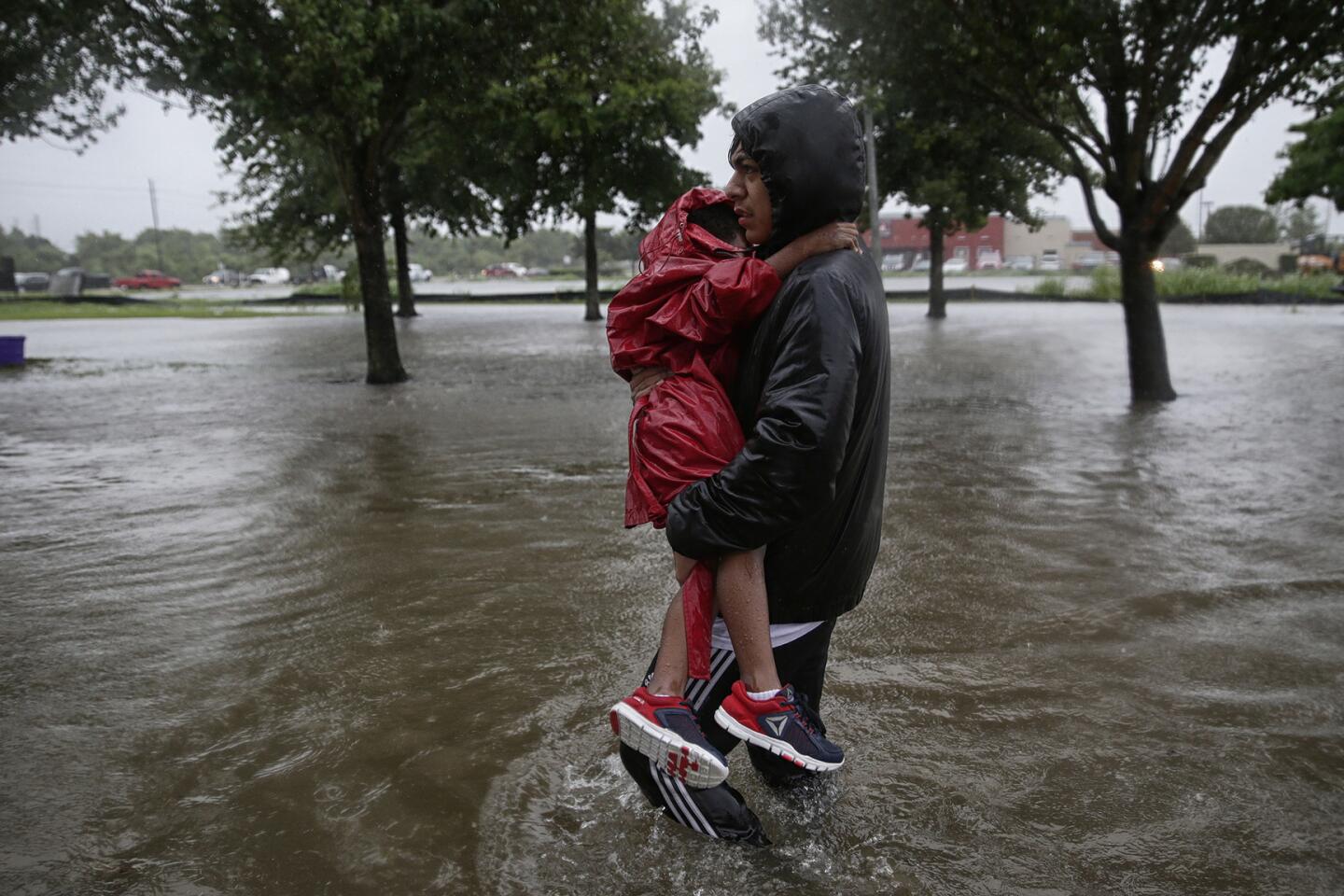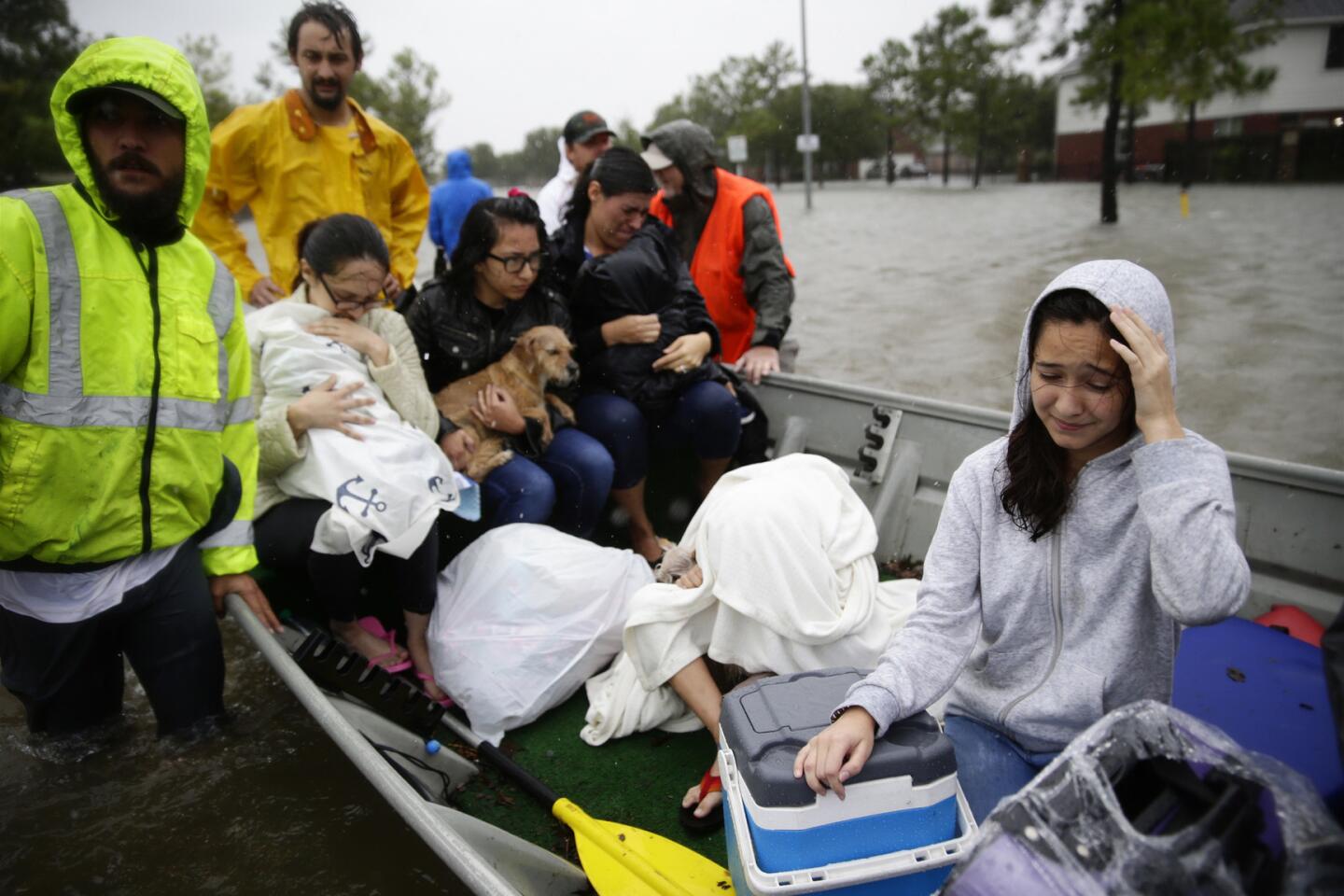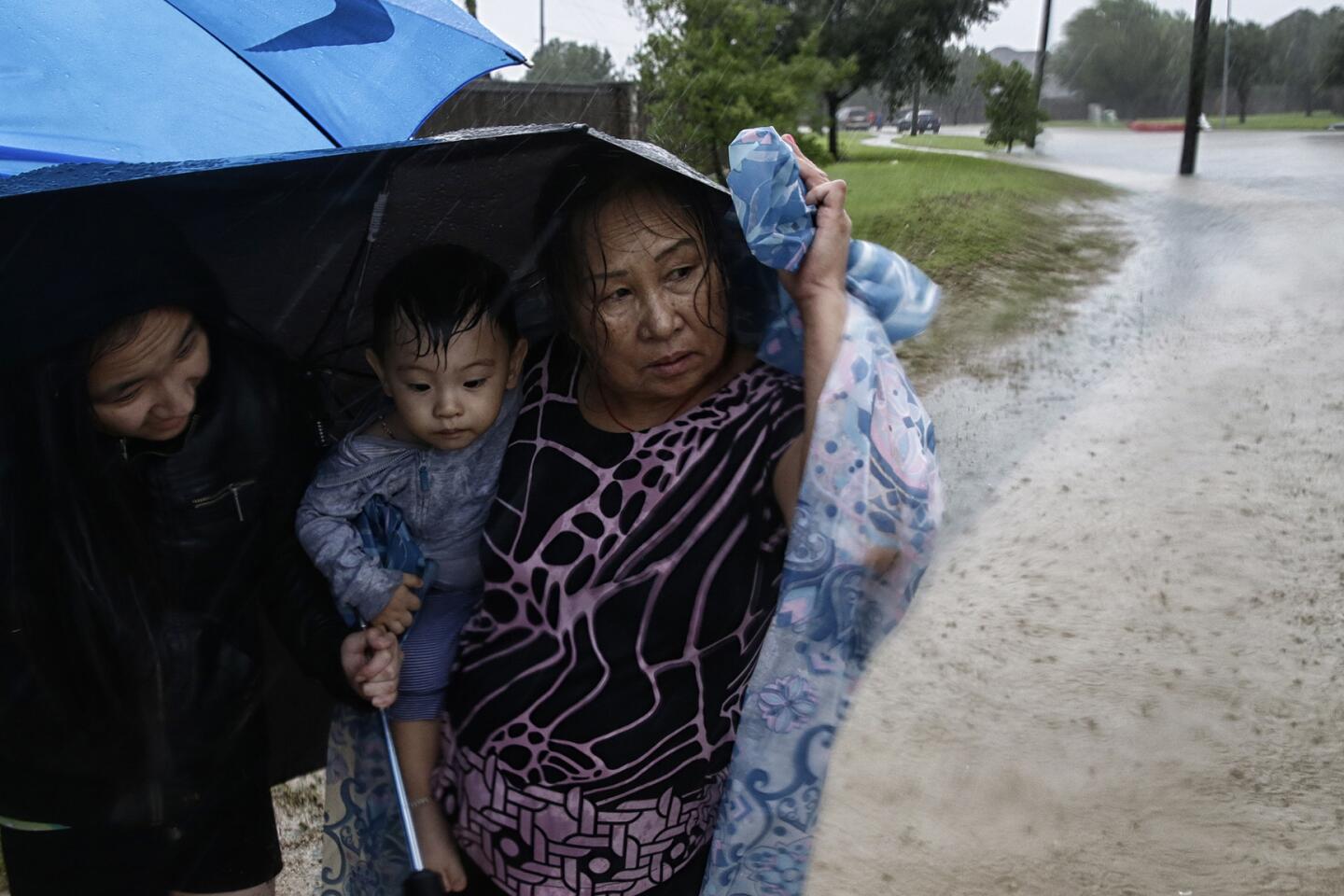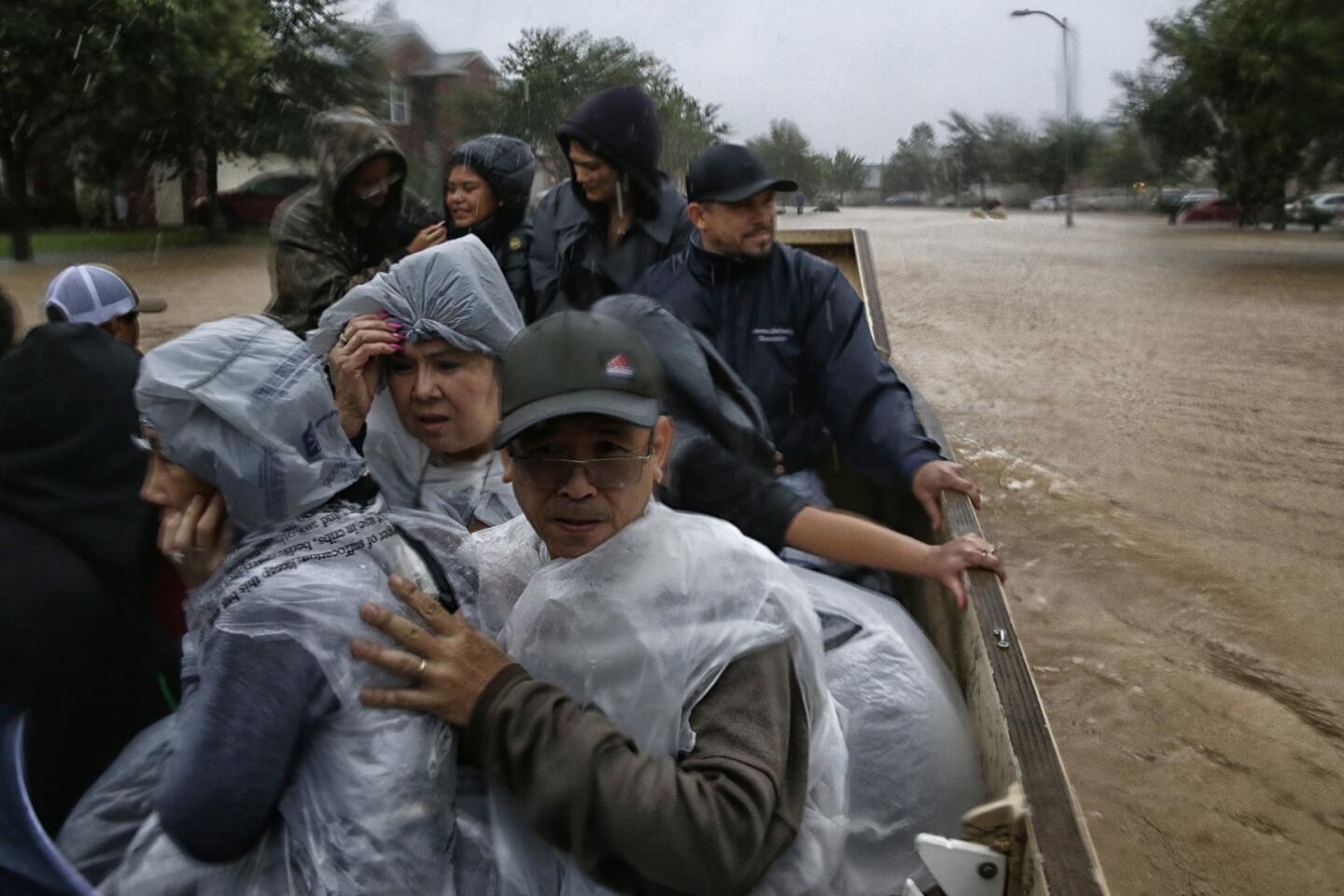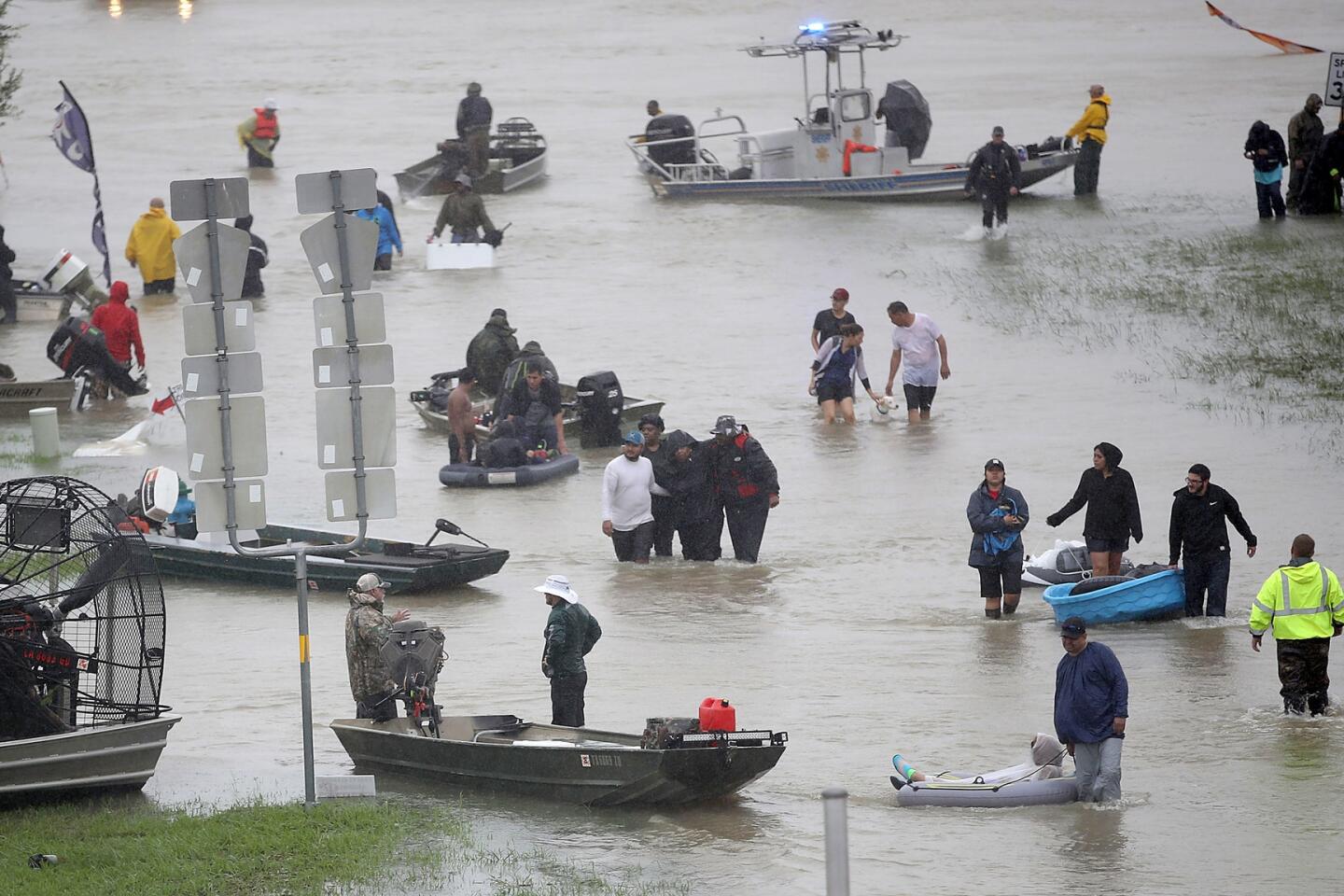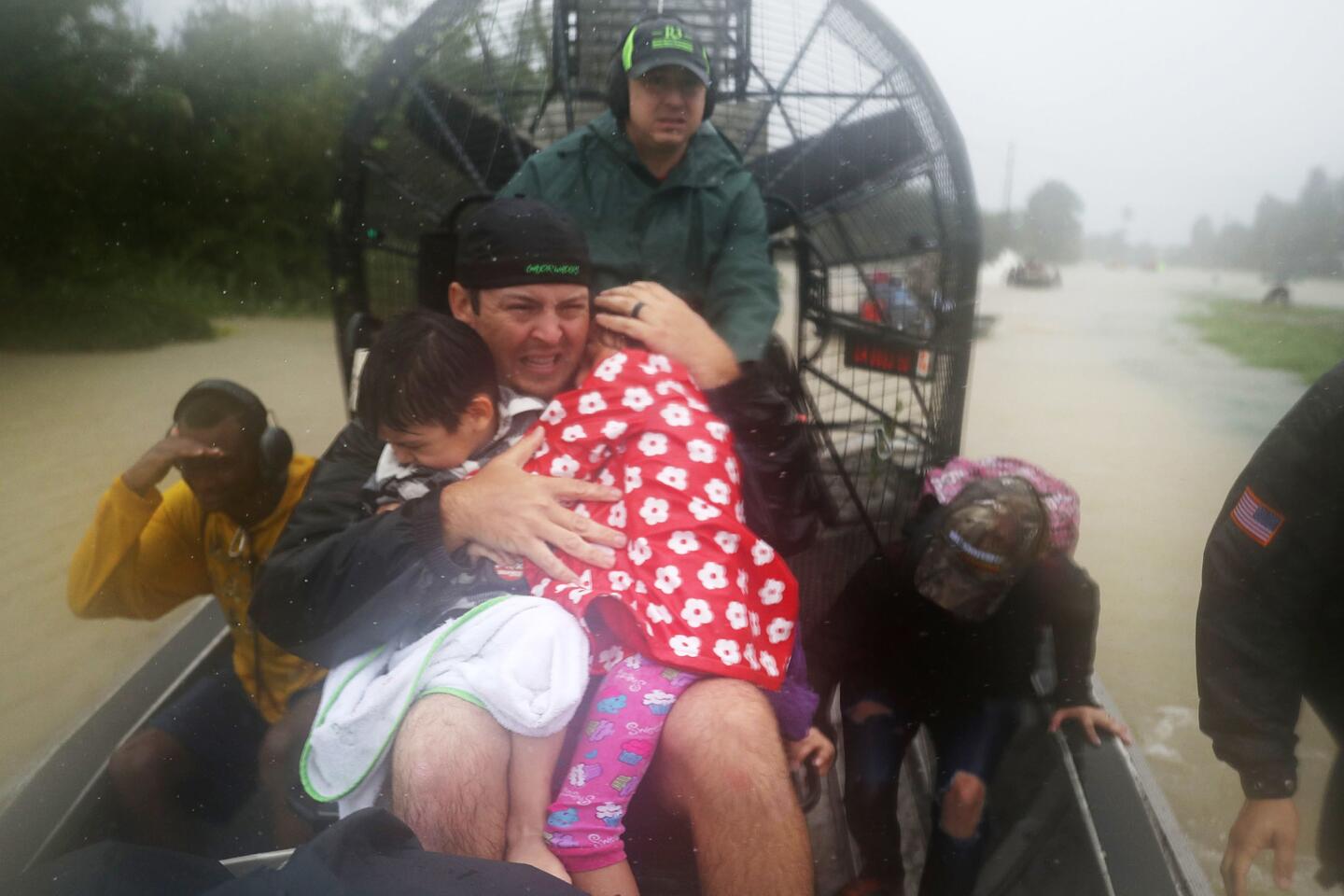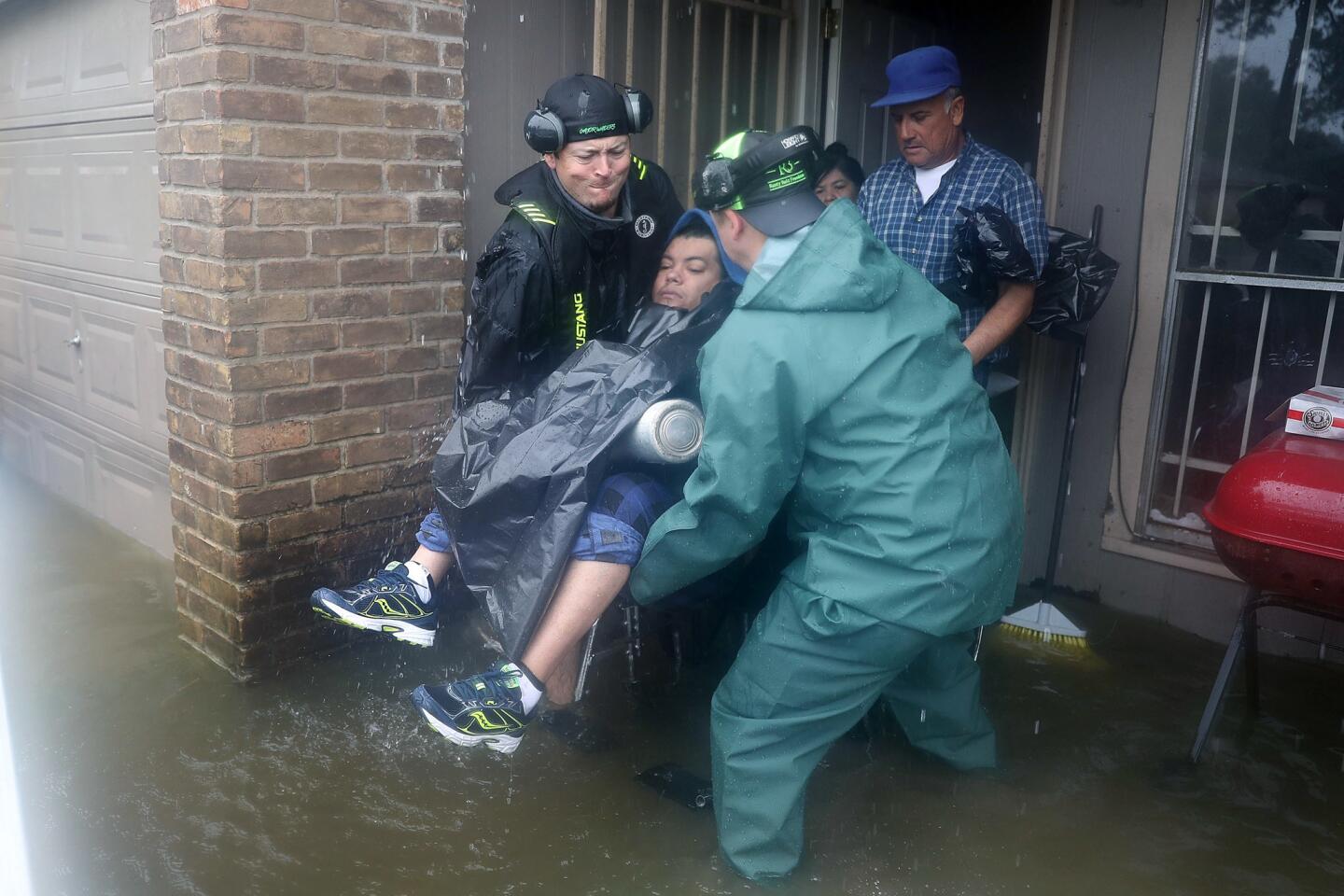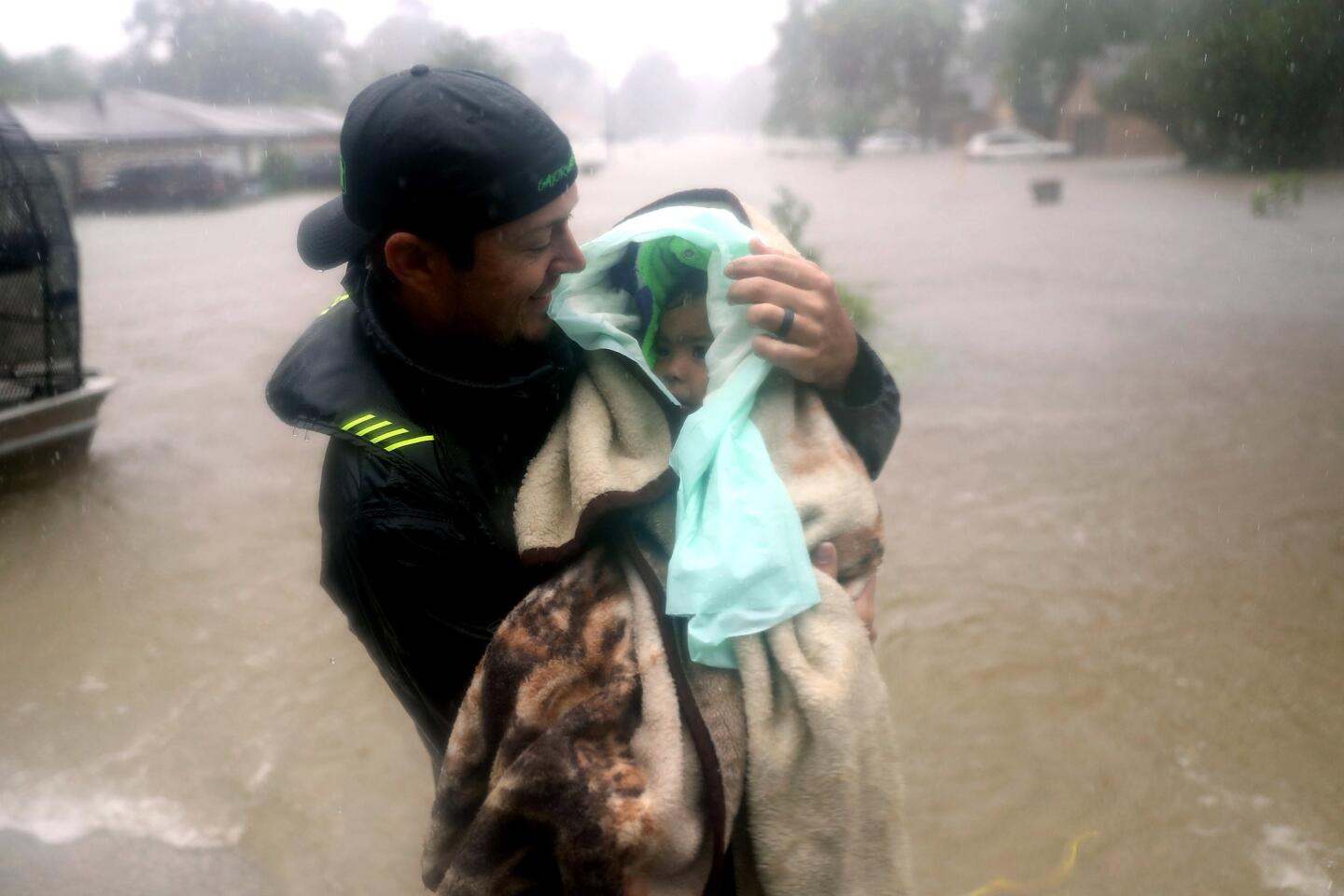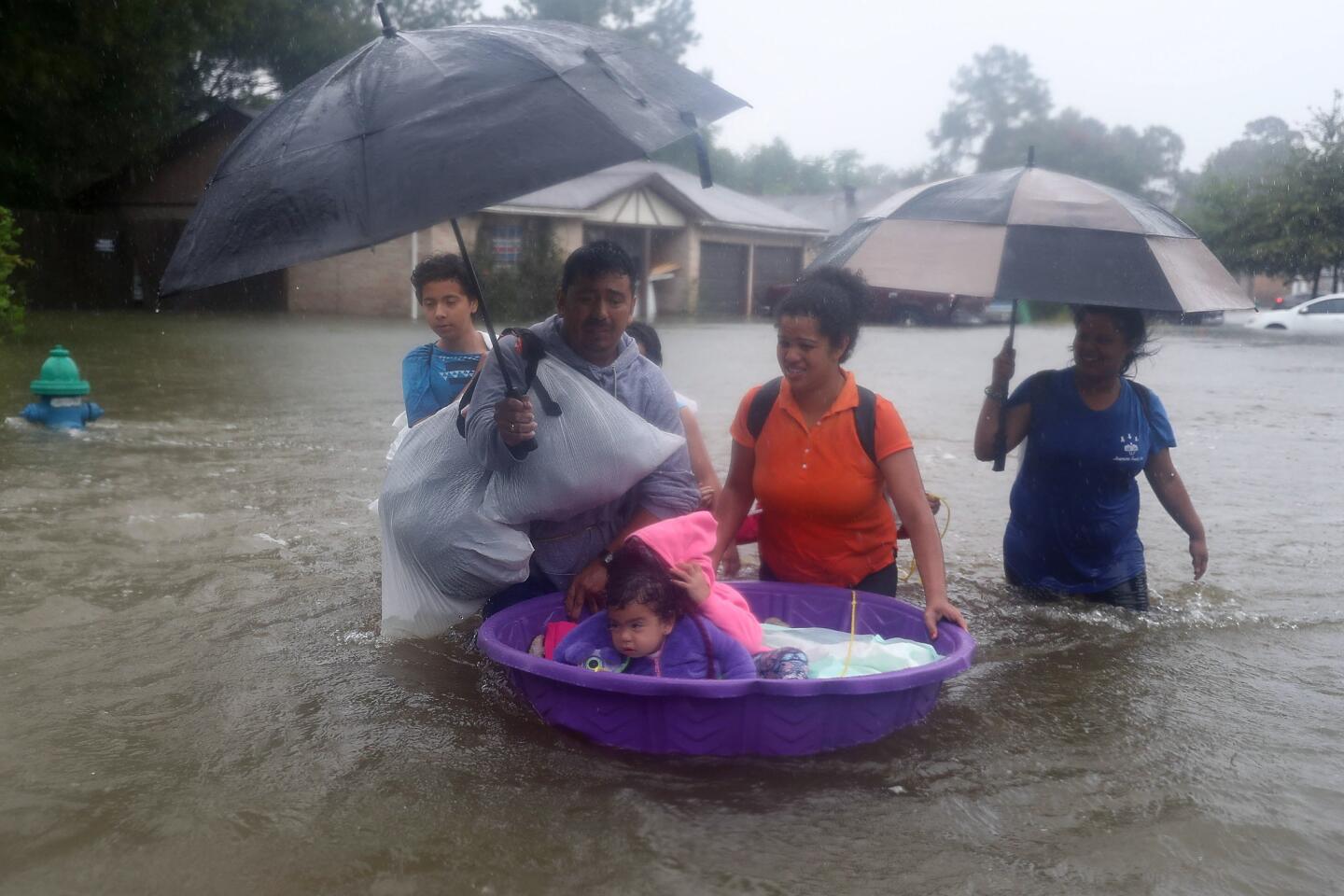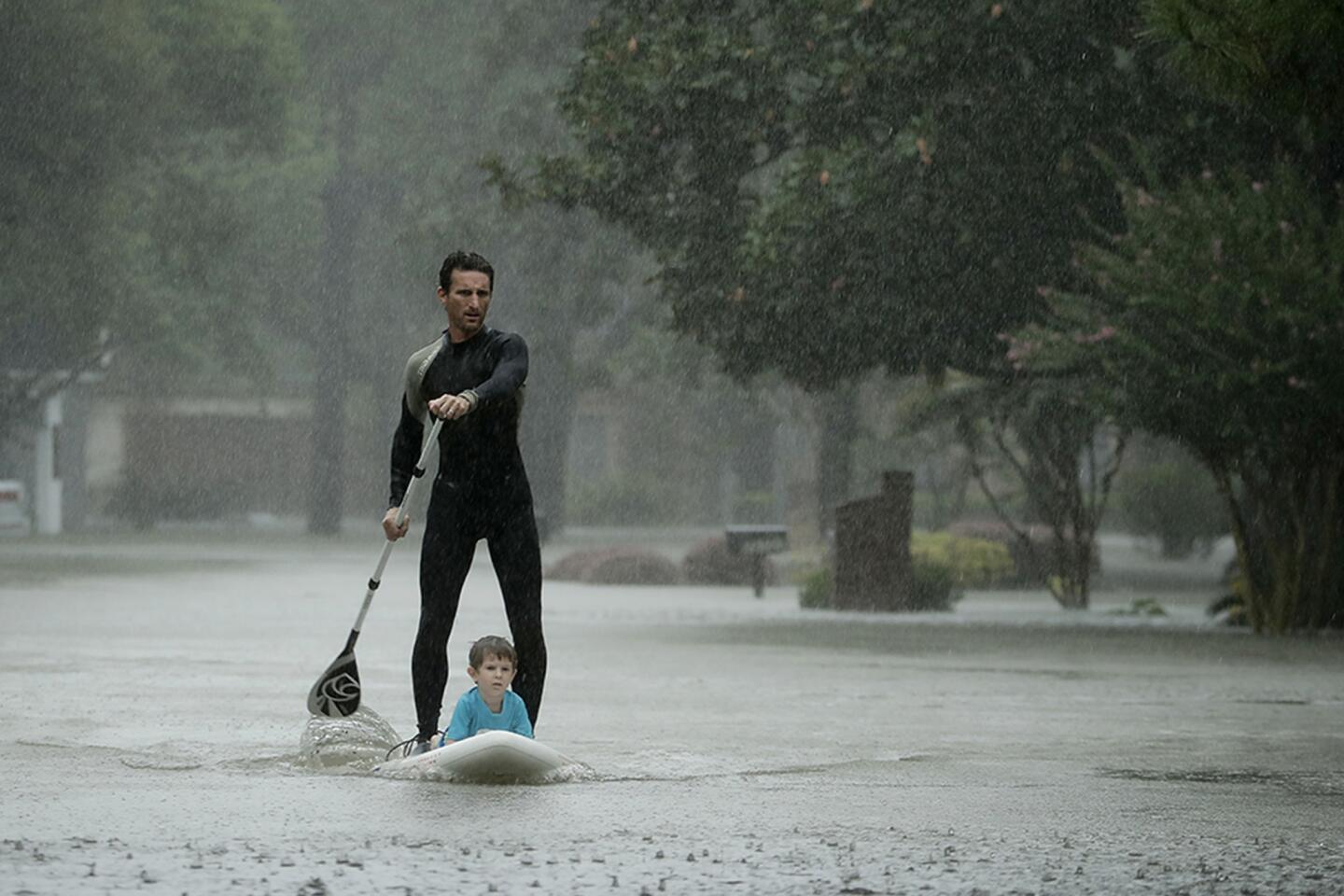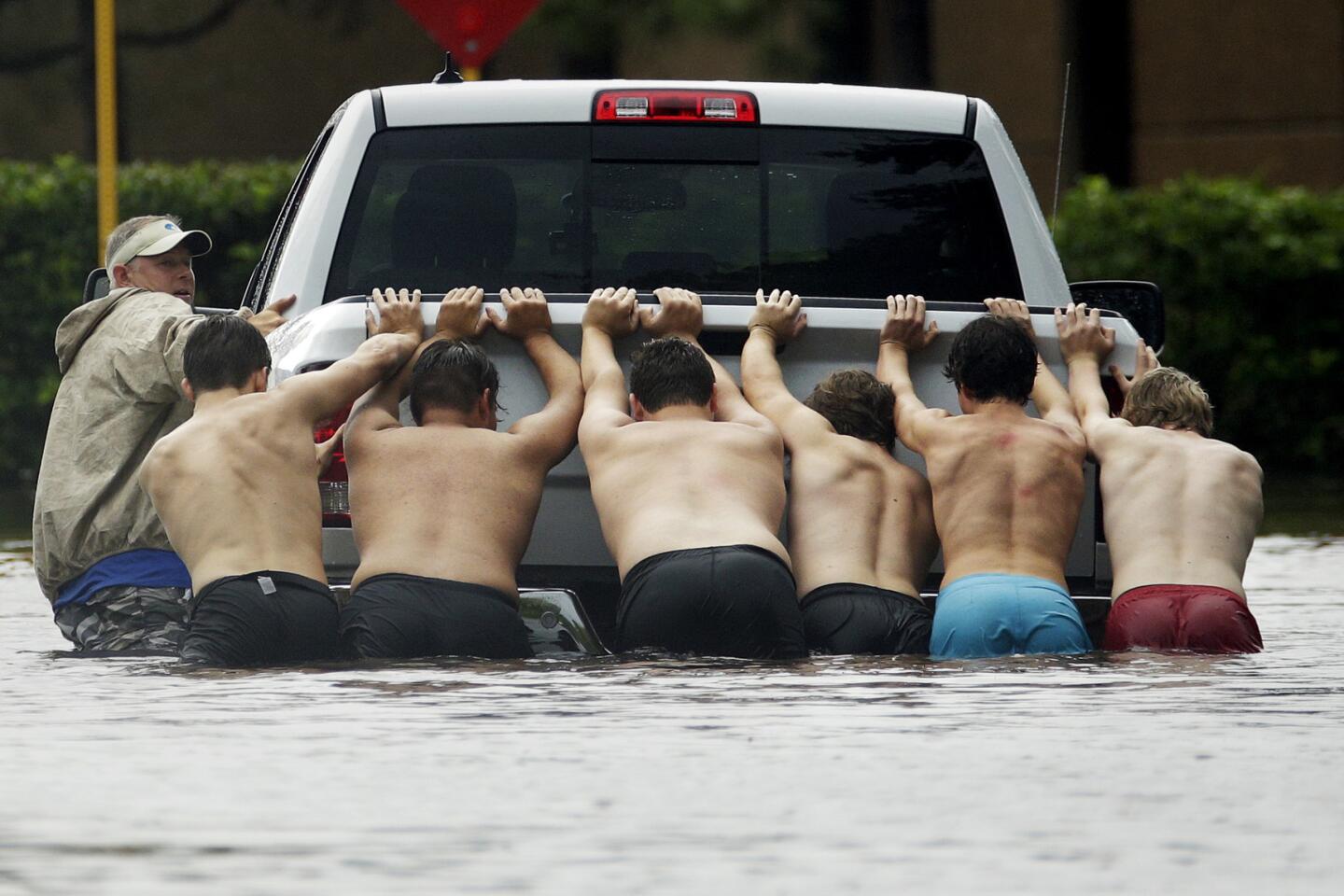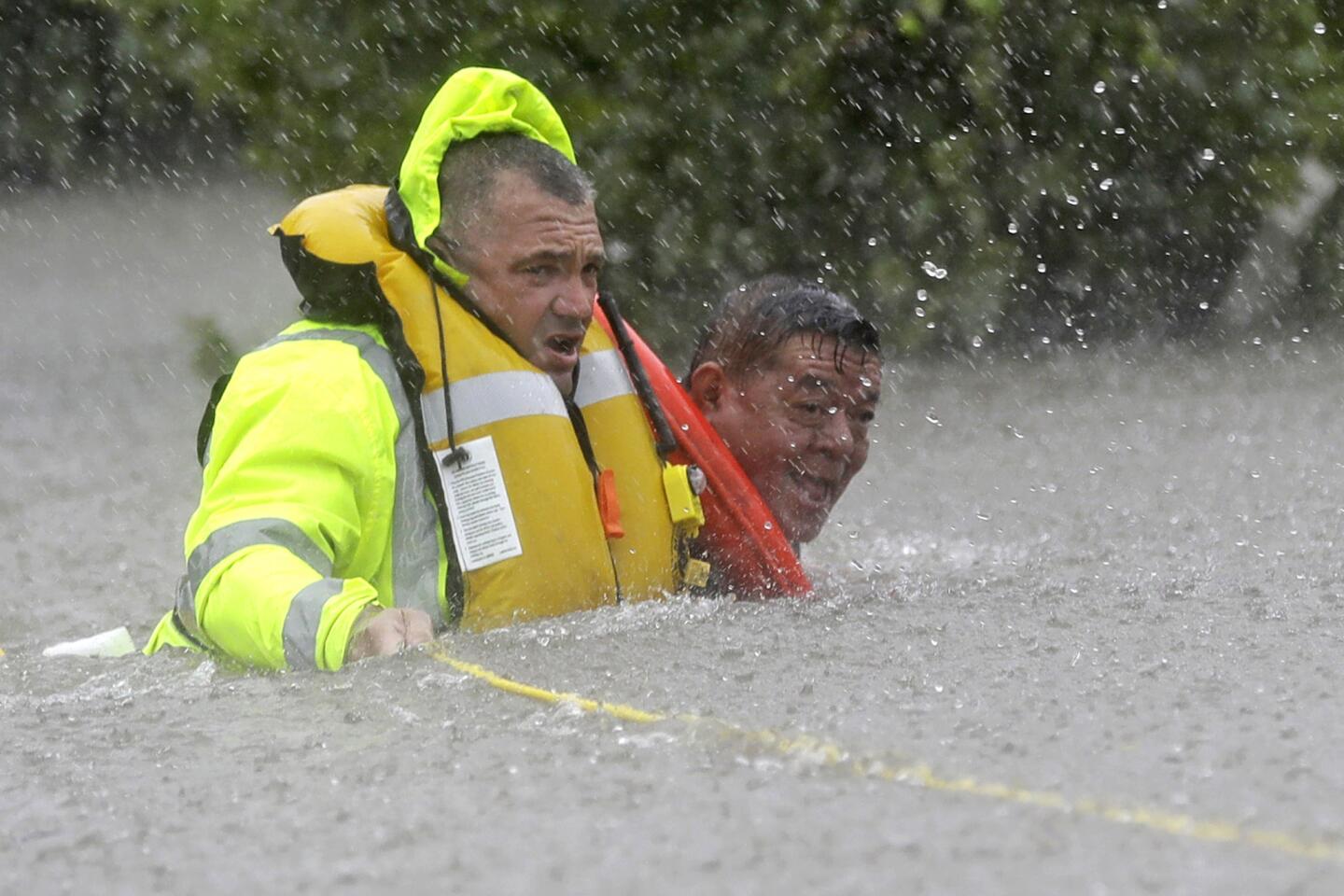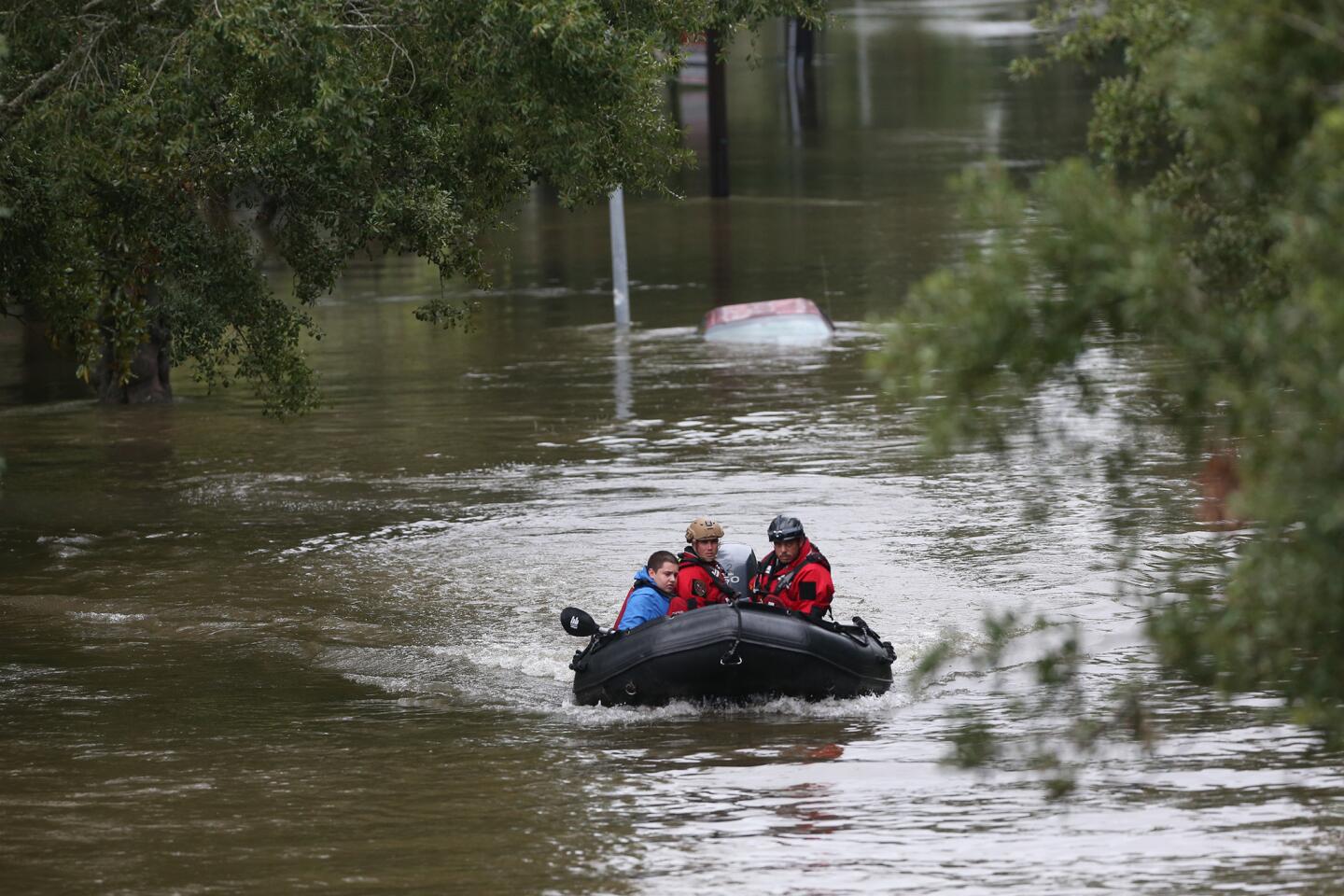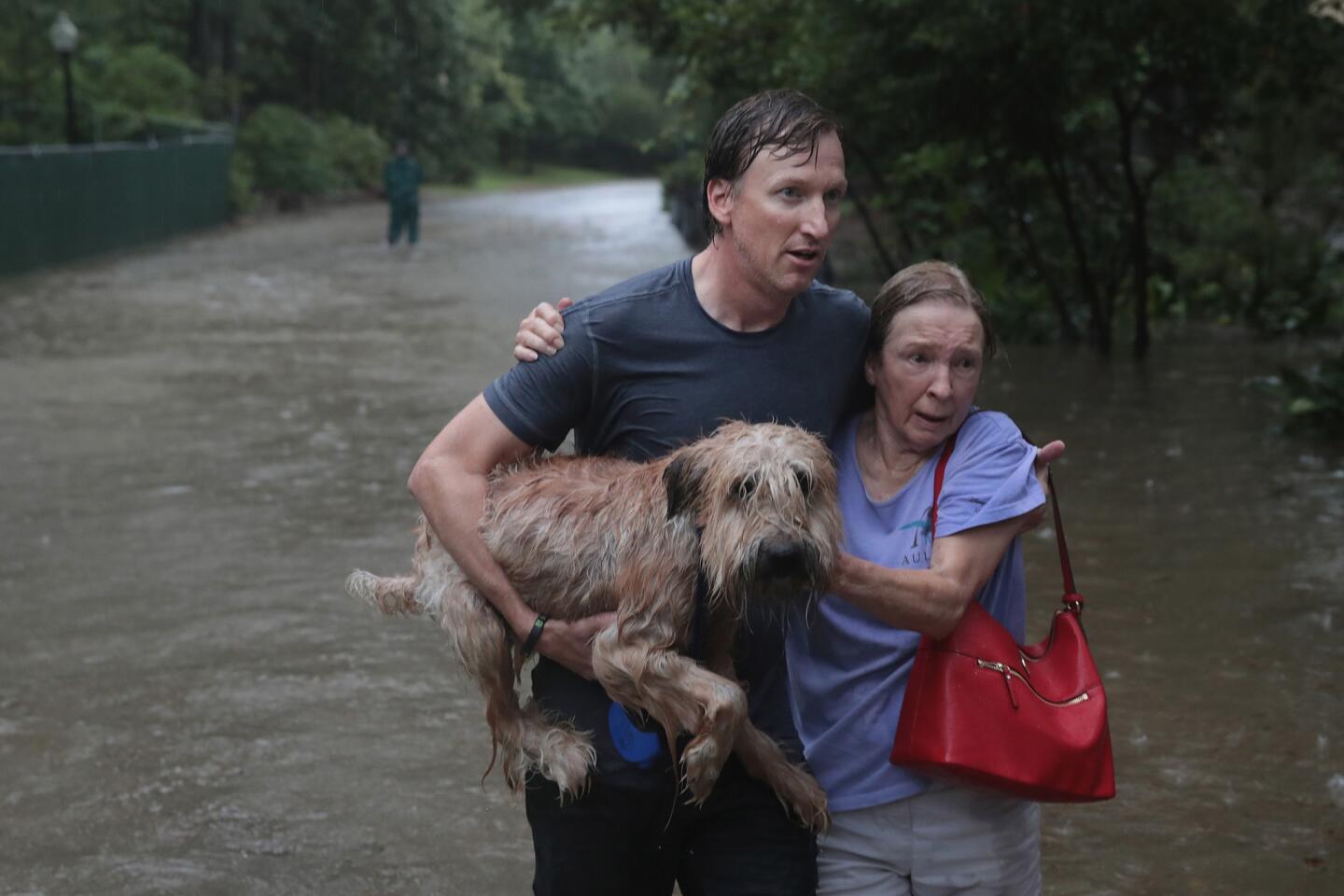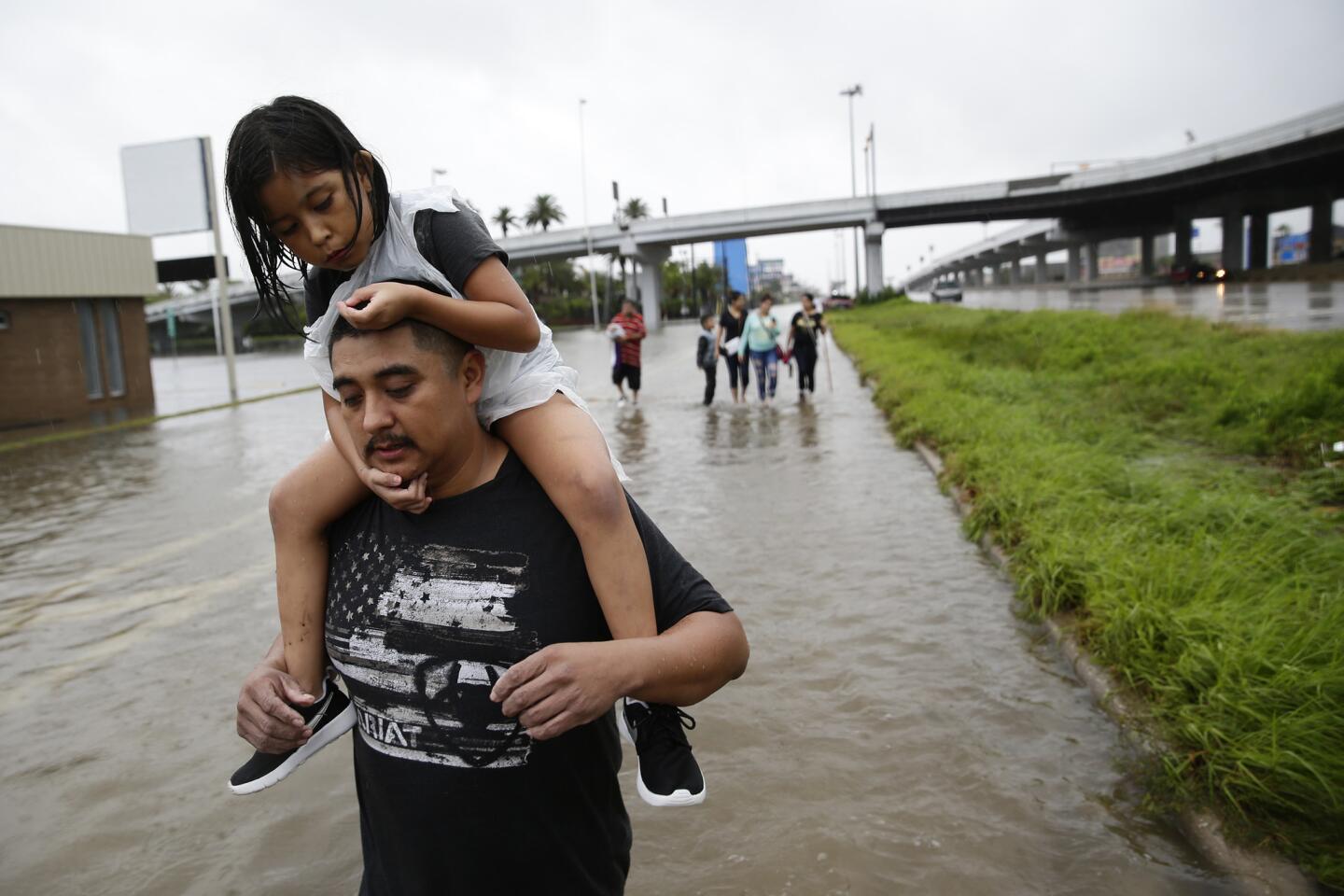Reporting from Beaumont, Texas — As some Houston residents Friday faced the heartache of evacuating their homes again due to water expected from reservoir releases, parts of Texas south of the city were bracing for potentially deadly flooding from overflowing rivers.
The coastal city of Lake Jackson, about an hour south of Houston, Friday issued emergency mandatory evacuation orders for two subdivisions threatened by the overflowing Brazos River. Voluntary evacuation orders were also extended to thousands of other residents along the Brazos and San Bernard rivers, said Brazoria County spokeswoman Sharon Trower.
“The deal is that we’re at the end of the line, everybody else’s rainfall is pouring into our rivers, so we’re being affected now,” Trower said.
Meanwhile, Houston Mayor Sylvester Turner asked people in 15,000 to 20,000 homes that had already been inundated in the western part of the city to evacuate again because reservoir releases were likely to send still more water pouring into their neighborhoods.
The releases from the Addicks and Barker reservoirs, which are likely to continue for about two weeks, are part of the effort to control more widespread flooding that has plagued the nation’s fourth-largest city since Hurricane Harvey made landfall a week ago.
The new evacuation requests came just as apprehensive residents across the region began making their way back to swamped dwellings, being warned only to return in daylight and to keep a wary eye out for wildlife, especially snakes. One Lake Houston resident came home to a 6-foot alligator in the living room.
In a partially flooded neighborhood three blocks north of the Buffalo Bayou, in western Houston, residents were resigned to the news that their homes might remain flooded for the foreseeable future. In hip waders and boats, they moved in and out of the water to gather their belongings. Someone handwrote a sign and hung it from a street sign, “If you loot, we shoot,” with a drawing of a gun.
John Latrobe, a lawyer, 44, hauled paintings and a picture through the water in a plastic tub. He hadn’t heard the news that flood officials think the dam releases might continue 10 to 15 more days. His home had survived the initial round of flooding.
When the releases came, however, it was a different story, and his property was inundated. Fortunately, Latrobe said he had flood insurance, which he’d gotten approved right before the storm, on Aug. 18. “Best $360 I ever spent.”
Lacy Johnson and her family of four evacuated from their home Wednesday and were hoping to return to the Lakeside Place subdivision, but the reservoir releases may make that impossible anytime soon.
When officials started releasing water from the reservoir Tuesday night, neighbors closer to the bayou “woke up to find themselves flooded and trapped in their houses,” she said.
As airboats rescued neighbors and military planes circled overhead, she and others called neighborhood officials. Johnson said she pleaded with them “not to release any more water because it was flooding out here.”
Johnson, 39, an assistant professor of creative writing at Rice University, left with her husband and two children, ages 6 and 10. Their home of four years was still dry, and had never flooded before, but as rushing water rose in the street, they decided to escape while they still could.
“It’s really hard to live with two small kids in an island of fetid water,” said Johnson, whose family was staying with friends in northwest Houston.
Still, Johnson said of the releases, “They’re doing the right thing. It’s an inconvenience. But if our neighborhood has to be flooded to save the city, so be it.”
By the latest count, the storm killed at least 47 people, forced the rescue of more than 72,000 and caused as much as a $100 billion in damage.
1/87
Samir Novruzov wades through water to get to a vehicle after spending the day clearing out his flooded home in Katy, Texas.
(Marcus Yam / Los Angeles Times) 2/87
Melissa Teague, right, instructs her children Andrew and Emily as they clear out their flooded home in Katy, Texas, on Monday.
(Marcus Yam / Los Angeles Times) 3/87
People ride through floodwaters in Katy, Texas.
(Marcus Yam / Los Angeles Times) 4/87
People hop off Chris Ginter’s truck as he helps ferry residents around Katy, Texas.
(Marcus Yam / Los Angeles Times) 5/87
Two men collect a disposed mattress as residents in the Trinity/Houston Garden area of northeast Houston gut their flooded homes.
(Robert Gauthier / Los Angeles Times) 6/87
Wayne Christopher, center, weeps as his wife, Helen, looks on during a Sunday service at First United Methodist Church in Dickinson, Texas.
(Marcus Yam / Los Angeles Times) 7/87
Hurricane Harvey severely damaged the First Baptist Church in Rockport, Texas. Worshipers on Sunday brought their own chairs to take part in an outdoor service.
(Robert Gauthier / Los Angeles Times) 8/87
Ken Garrett, right, hugs Pastor Jordan Mims after they both delivered prayers on the grounds of the First Baptist Church in Rockport, Texas.
(Robert Gauthier / Los Angeles Times) 9/87
University of Houston law professor Johnny Buckles props up an American flag on the debris pile from his flood-damaged home in the Kingwood area of north Houston.
(Robert Gauthier / Los Angeles Times) 10/87
Jose Esquivel flags down motorists to visit a parking lot full of donated clothes, supples, water and brisket in Refugio, Texas.
(Robert Gauthier / Los Angeles Times) 11/87
Despite heavy damage and no electricity, a homeowner displays his patriotism while clean up and recovery efforts continue in his devastated neighborhood of Rockport.
(Robert Gauthier / Los Angeles Times) 12/87
Volunteers from the Ahmadiyya Muslim Youth Association, Yusuf Seager, from left, Rahib Ahmed, Rahman Nasir, and Khalil Nasir help tear out drywall damaged by floodwater in the Westbury neighborhood in Houston.
(Marcus Yam / Los Angeles Times) 13/87
Volunteers from the Ahmadiyya Muslim Youth Association help residents of the Westbury neighborhood in Houston clear debris from their homes. It is also the Islamic holiday of Eid-ul-Adha. (Marcus Yam / Los Angeles Times)
(Marcus Yam / Los Angeles Times) 14/87
Many roads and Interstates in Texas remain flooded, including this one in west Houston. (Robert Gauthier / Los Angeles Times)
15/87
Jenna Fountain and her father Kevin carry a bucket down Regency Drive to try to recover items from their flooded home in Port Arthur, Texas on Thursday.
(Emily Kask / AFP / Getty Images) 16/87
Lillie Roberts talks with family members as contractor Jerry Garza begins the process of repairing her Houston home on Friday.
(Scott Olson / Getty Images) 17/87
Volunteers from the Ahmadiyya Muslim Youth Association to perform holy prayer as they help local residents in the Kashmere Gardens area of Houston clean out their flooded homes.
(Marcus Yam / Los Angeles Times) 18/87
Volunteers assist Cornell Beasley with repairs to his damaged home in Houston on Friday.
(Scott Olson / Getty Images) 19/87
Katie Estridge organizes hundreds of soaked family photographs on the front lawn of her father’s home in northeast Houston.
(Robert Gauthier / Los Angeles Times) 20/87
Wes Higgins wipes sweat from his face after spending five days patrolling flooded Houston neighborhoods in his boat. Higgins, from Knott, Texas, organized a volunteer team of 10 boats to help Houston residents.
(Robert Gauthier / Los Angeles Times) 21/87
Members of the California Air National Guard 129th Rescue Wing, Senior Airman George McKenzie, left, and Master Sgt. Adam Vanhaaster, right, help a man carry his infant, who has a serious medical condition, to a hospital in Orange, Texas.
(Marcus Yam / Los Angeles Times) 22/87
A search-and-rescue crew speeds along Maple Rock Drive in west Houston looking for flood victims.
(Robert Gauthier / Los Angeles Times) 23/87
A woman and a child are among those rescued by California Air National Guardsmen in Lumberton, north of Beaumont.
(Marcus Yam / Los Angeles Times) 24/87
California Air National Guard 129th Rescue Wing’s Master Sgt. Adam Vanhaaster searches for people in need of help near Lumberton.
(Marcus Yam / Los Angeles Times) 25/87
A man prepares his dinner at home near Lumberton.
(Marcus Yam / Los Angeles Times) 26/87
Boys sit on a damaged railroad track near Lumberton.
(Marcus Yam / Los Angeles Times) 27/87
A woman waves to a California Air National Guard helicopter from her neighborhood near Lumberton.
(Marcus Yam / Los Angeles Times) 28/87
A drop-off point for boat rescues in Lumberton.
(Marcus Yam / Los Angeles Times) 29/87
Baseball fields in Lumberton are inundated.
(Marcus Yam / Los Angeles Times) 30/87
Coca-Cola delivery trucks are trapped by floodwater in Lumberton, Texas.
(Marcus Yam / Los Angeles Times) 31/87
A military search and rescue helicopter refuels mid-flight before resuming nighttime missions over areas flooded in the aftermath of Tropical Storm Harvey.
(Marcus Yam / Los Angeles Times) 32/87
Houston police search a flooded home after hearing that an elderly couple lived there. The house was empty. Police later learned the couple had safely evacuated.
(Robert Gauthier / Los Angeles Times) 33/87
West Houston resident Pedro Albiso uses trash bags to protect his shoes and pants as he prepares to cross a flooded street.
(Robert Gauthier / Los Angeles Times) 34/87
Patients are evacuated from Baptist Hospitals of Southeast Texas after the city of Beaumont lost its water supply.
(Marcus Yam / Los Angeles Times) 35/87
Fatima Flores, 12, gets her hair done by cousins Shelly Flores, 7, left, and Ashley Flores, 7, as their family takes shelter at Max Bowl, a bowling alley in Port Arthur, Texas.
(Marcus Yam / Los Angeles Times) 36/87
James Benoit, left, and George Clipton sought refuge at Max Bowl in Port Arthur, Texas.
(Marcus Yam / Los Angeles Times) 37/87
June Ayrow spent the night with his oxygen tanks underneath a table at Max Bowl in Port Arthur, Texas.
(Marcus Yam / Los Angeles Times) 38/87
Floodwaters surround homes Thursday in Port Arthur, Texas.
(Gerald Herbert / Associated Press) 39/87
Volunteers rescue patients from the Cypress Glen nursing home where floodwaters trapped dozens of elderly patients in Port Arthur, Texas on Wednesday.
(Marcus Yam / Los Angeles Times) 40/87
Residents lie on sofas as they wait to be evacuated from the Cypress Glen senior care facility in Port Arthur, Texas, which was inundated with floodwaters from Tropical Storm Harvey on Wednesday.
(Matt Pearce / Los Angeles Times) 41/87
Emergency crews help rescue elderly residents from the Golden Years Assisted Living home in Orange, Texas, on Wednesday.
(Gerald Herbert / Associated Press) 42/87
Rescuer workers help a woman from her flooded home n Port Arthur, Texas.
(Joe Raedle / Getty Images) 43/87
Evacuees ride on a truck after they were driven from their homes by the flooding in Port Arthur, Texas.
(Joe Raedle / Getty Images) 44/87
People wait in line to buy groceries at a Food Town during the aftermath of Tropical Storm Harvey.
(Brendan Smialowski / AFP/Getty Images) 45/87
Juan Figueroa removes damaged furniture from his mother’s northeast Houston home where residents begin rebuilding from the devastating effects of the storm.
(Robert Gauthier / Los Angeles Times) 46/87
Rafael Minor, left, and Miguel Ramirez remove the contents from a flooded home in northeast Houston on Wednesday.
(Robert Gauthier / Los Angeles Times) 47/87
A construction crew cleans out a home that was flooded by Tropical Storm Harvey in Spring, Texas.
(Brett Coomer / Associated Press) 48/87
A flooded residential neighborhood near Interstate 10 in Houston, Texas.
(Marcus Yam / Los Angeles Times) 49/87
A flooded residential neighborhood near Interstate 10 in Houston, Texas.
(Marcus Yam / Los Angeles Times) 50/87
People come out to view the flooded areas near their homes in Houston, Texas.
(Marcus Yam / Los Angeles Times) 51/87
CaroLine Kirkpatrick of Salt Lake City, Utah, is evacuated from the Omni Hotel by rescue worker Adam Caballero in Addicks, a suburb of Houston, Texas.
(Robert Gauthier / Los Angeles Times) 52/87
People displaced by flooding fill the shelter at the George R. Brown Convention Center in downtown Houston.
(LM Otero / Associated Press) 53/87
Mark Ocosta and his baby, Aubrey, take shelter at the George R. Brown Convention Center.
(Joe Raedle / Getty Images) 54/87
Frantzy Thenor receives an embrace from a fellow evacuee after he helped her leave from the flooded Omni Hotel, in the Addicks area of Houston, Texas.
(Robert Gauthier / Los Angeles Times) 55/87
Storm clouds over Houston skyline.
(Marcus Yam / Los Angeles Times) 56/87
Recreational vehicles sit on their sides in flood water in Houston, Texas.
(Marcus Yam / Los Angeles Times) 57/87
A woman carries a dog above the rising floodwaters near Addicks Reservoir.
(Robert Gauthier / Los Angeles Times) 58/87
Eduardo Retiz, 21, drives his elevated pickup truck through a flooded street near Addicks Reservoir.
(Robert Gauthier / Los Angeles Times) 59/87
Mike Hoskovec, left, walks to a boat after helping friend Ben Berg, behind, move some photo albums to the second floor of his Nottingham Woods home.
(Robert Gauthier / Los Angeles Times) 60/87
Matthew Koser looks for important papers and heirlooms inside his grandfather’s house after it was flooded by heavy rains.
(Erich Schlegel / Getty Images) 61/87
Residents wade through floodwaters as they evacuate their homes near the Addicks Reservoir Tuesday.
(David J. Phillip / Associated Press) 62/87
Larry Koser Jr., left and his son Matthew look for important papers and heirlooms inside Larry Koser Sr.’s house after it was flooded by heavy rains.
(Erich Schlegel / Getty Images) 63/87
Portions of Interstate 10 remain flooded in Houston, Texas.
(Marcus Yam / Los Angeles Times) 64/87
Rising flood waters stranded hundreds of residents of Twin Oaks Village in Clodine.
(Robert Gauthier / Los Angeles Times) 65/87
Comfort Morgan is helped to dry land after being rescued from her flooded home in Twin Oaks Village in Clodine.
(Robert Gauthier / Los Angeles Times) 66/87
Rising flood waters stranded hundreds of residents of Twin Oaks Village in Clodine, where a collection of small boat owners, including some with pool toys, coordinated to bring most to dry ground.
(Robert Gauthier / Los Angeles Times) 67/87
Rising flood waters stranded hundreds of residents of Twin Oaks Village in Clodine, where an collection of small boat owners coordinated to bring most to dry ground.
(Robert Gauthier / Los Angeles Times) 68/87
Hundreds of residents of Twin Oaks Village are evacuated in Clodine Monday.
(Robert Gauthier / Los Angeles Times) 69/87
Residents are stranded at Twin Oaks Village in Clodine due to rising flood water.
(Robert Gauthier / Los Angeles Times) 70/87
Stranded residents of Twin Oaks Village in Clodine are evacuated from the rising flood water.
(Robert Gauthier / Los Angeles Times) 71/87
Jan Tullos, 32, searches a flooded home for an injured woman who was reportedly stranded inside in Clodine, Texas. The home was empty.
(Robert Gauthier / Los Angeles Times) 72/87
People walk down a flooded Houston street as they evacuate their homes after the area was inundated with rains from Tropical Storm Harvey.
(Joe Raedle / Getty Images) 73/87
Dean Mize holds children as he and Jason Legnon use an airboat to rescue people from flooded homes in Houston on Monday.
(Joe Raedle / Getty Images) 74/87
Dean Mize, left and Jason Legnon carry a person to an airboat as they rescue people in Houston.
(Joe Raedle / Getty Images) 75/87
Evacuees walk down a flooded street after leaaving their homes Monday in Houston.
(Joe Raedle / Getty Images) 76/87
Dean Mize holds a child as he helps evacuate people in Houston as Tropical Storm Harvey continues to drench southeastern Texas and Louisiana with heavy rains and surging floodwaters.
(Joe Raedle / Getty Images) 77/87
People evacuate their flooded homes on Monday in Houston. By Monday morning, 911 operators had received 56,000 calls, city officials said.
(Joe Raedle / Getty Images) 78/87
Adults use a kiddie pool to transport children as they evacuate on Monday.
(Joe Raedle / Getty Images) 79/87
People catch a ride on a construction vehicle down a flooded Houston street.
(Joe Raedle / Getty Images) 80/87
Alexendre Jorge evacuates Ethan Colman, 4, from a Houston neighborhood inundated by floodwaters from Tropical Storm Harvey.
(Charlie Riedel / AP) 81/87
People push a stalled pickup to through a flooded street in Houston on Sunday, as Tropical Storm Harvey dumped heavy rains.
(Charlie Riedel / Associated Press) 82/87
A Houston police officer helps Frank Andrews, 74, into his walking chair after rescuing him from his flooded home in the Braeswood Place neighborhood, southwest of Houston, on Sunday.
(Robert Gauthier / Los Angeles Times) 83/87
Wilford Martinez, right, is rescued from his flooded car by Harris County Sheriff’s Department Richard Wagner along Interstate 610 in Houston, Texas.
(David J. Phillip / Associated Press) 84/87
Daniel Gross, 15, is rescued by Houston police after he was stranded on top of his car in southwest Houston.
(Robert Gauthier / Los Angeles Times) 85/87
Andrew White, left, helps a neighbor down a street after rescuing her from her home in his boat in the upscale River Oaks neighborhood after it was inundated with flooding from Tropical Storm Harvey.
(Scott Olson / Getty Images) 86/87
Volunteers and officers from the neighborhood security patrol help rescue residents in Houston’s River Oaks neighborhood Sunday.
(Scott Olson / Getty Images) 87/87
Jesus Nunez carries his daughter Genesis, 6, as he and numerous family members flee their flooded home, walking nearly four hours to the safety of a relative’s house on Sunday.
(Robert Gauthier / Los Angeles Times) White House officials indicated earlier that they were putting together an initial, emergency financial aid package of about $6 billion.
President Trump offered words of encouragement Friday.
“Texas is healing fast thanks to all of the great men & women who have been working so hard,” Trump tweeted. “But still, so much to do. Will be back tomorrow!” Trump, who misspelled “healing” as “heeling” in the original tweet, plans to visit Texas and Louisiana on Saturday and has proclaimed Sunday a national day of prayer for storm victims.
Parts of Kentucky were projected to receive more than four inches of rain from Harvey’s remnants over the next 24 hours, with flash floods the main concern in the state’s mountainous regions.
Just as emergency officials are getting a chance to step back and assess the scope of the damage from Harvey, concern was switching to another powerful storm, Irma, brewing in the open Atlantic.
Despite clear skies over much of Texas, many rivers along the state’s coastal plains remained at major or record-high flood stages, which are projected to last for days, and waters remained high in many parts of Texas and western Louisiana.
About 70% of Harris County’s 1,777 square miles was covered with 1½ feet of water at some point after the deluge, flooding about 136,000 buildings, according to county officials.
Government offices in Beaumont remained closed after the region was hit with floods, costing the city its water supply and cutting off access to medical services such as dialysis and forcing hospital patients to evacuate.
Texas Gov. Greg Abbott, noting that low-lying places along rivers swollen with runoff remain “deadly dangerous,” announced the launch of the Rebuild Texas Fund with a $36-million pledge from the Michael & Susan Dell Foundation. The aim was to raise $100 million over Labor Day weekend to support recovery efforts.
West of Houston, the city of Rosenberg announced that its shelters would be closing as the waters moved on.
Meanwhile, federal officials have launched an investigation into a fire at a chemical plant in Crosby, east of Houston, that lost electrical power needed to cool volatile organic peroxide, leading to a pair of explosions Thursday. The plant, owned by Arkema Inc., has had Occupational Safety and Health Administration violations in the past, including a $110,000 fine this year for 10 violations found during an inspection.
In a call with reporters early Friday, Arkema officials said there are nine refrigerated trailers containing about 500,000 pounds of liquid organic peroxide at three various locations at the Crosby plant, and only one of them has exploded so far. Officials said there is a good chance the others could ignite.
Times staff writers Matt Pearce reported from Beaumont, Texas, Molly Hennessy-Fiske from Houston and Jack Dolan from Los Angeles. Times staff writer Laura J. Nelson in Los Angeles contributed to this report.
ALSO
Harvey is one of the costliest disasters in U.S. history. Most of the victims have no flood insurance
For Texas immigrants, Harvey came at an already tense time
‘I think he’s barbecuing’: A helicopter view of the Texas flood with the California National Guard
UPDATES:
3:40 p.m.: This article was updated with comments from residents coping with flooding.
1:10 p.m.: This article was updated with information on reservoir releases and overflowing rivers.
This story was originally published at 6:50 a.m

